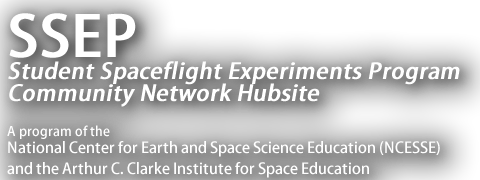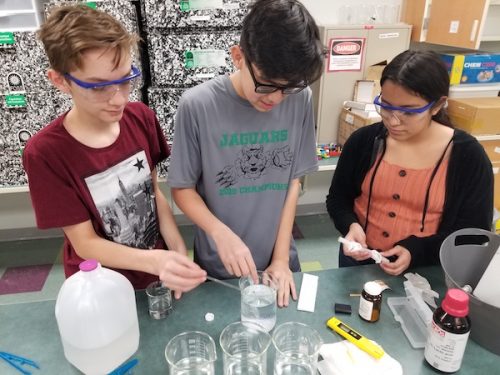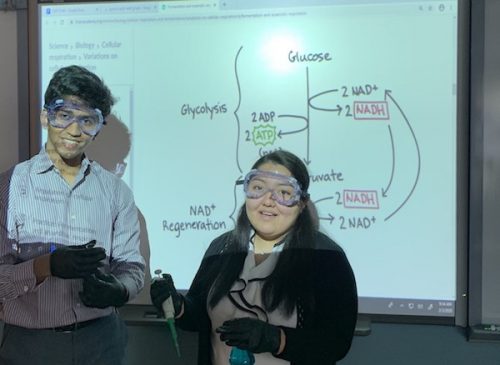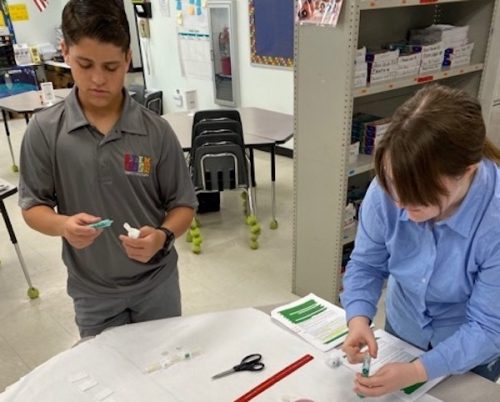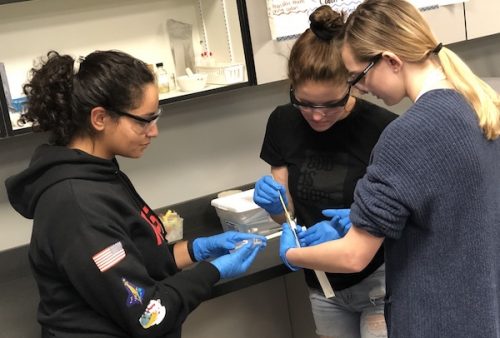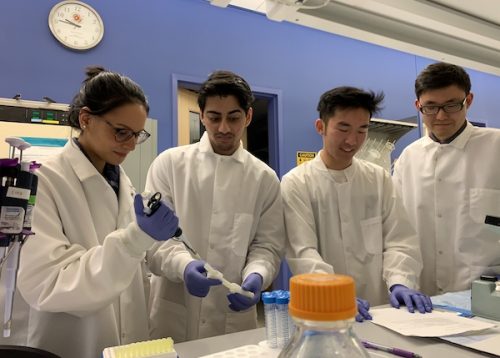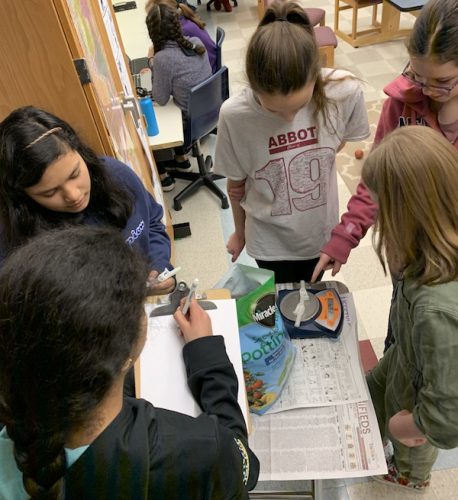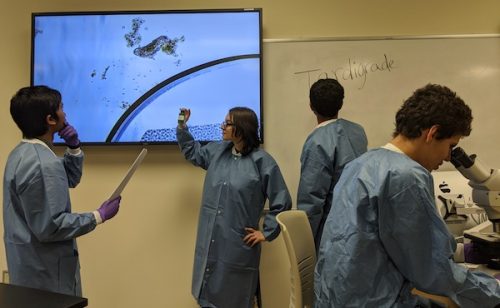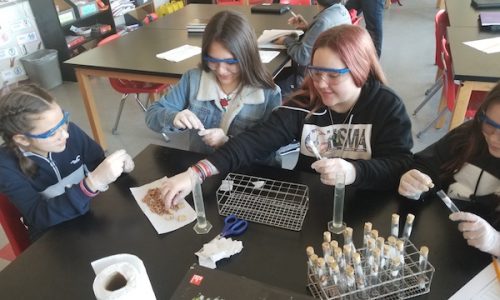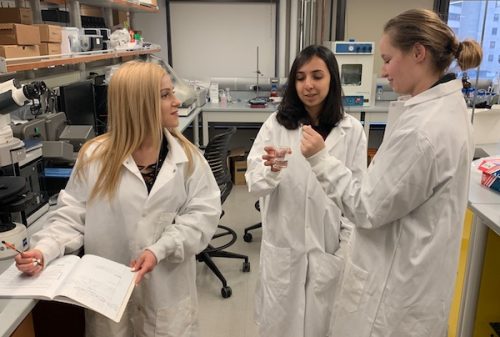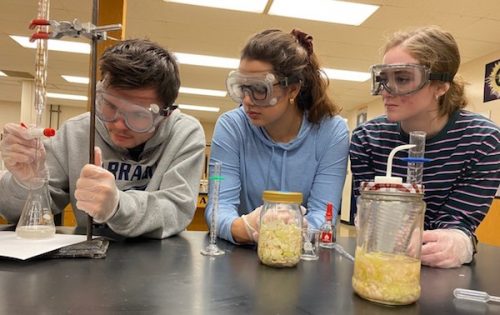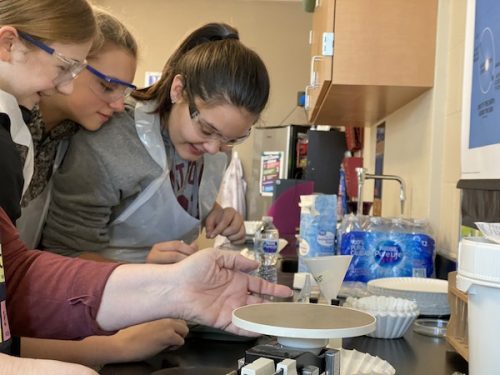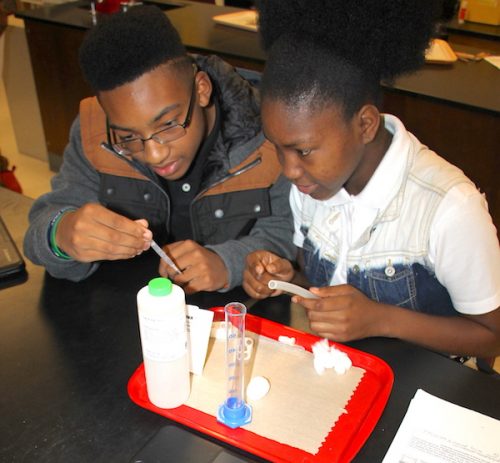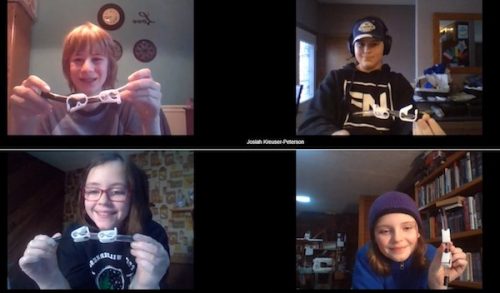The Student Spaceflight Experiments Program is proud to report that there were a total of 3,076 proposals submitted from student teams across the 32 communities participating in Mission 14 to ISS. Of those, 930 proposals were forwarded for review by Step 1 Review Boards in each of the communities. Each Step 1 Review Board selected up to three finalist proposals, which were submitted to the National SSEP Step 2 Review Board.
On December 1-2, 2019 the Step 2 Review Board met at the NASA Goddard Spaceflight Center’s Visitor Center in Greenbelt, MD, reviewed all 97 finalist proposals, and selected one proposed experiment to fly for 31 communities and two proposed experiments for one community, for a total of 33 flight experiments. By December 17, 2019, the National Center for Earth and Space Science Education and the Arthur C. Clarke Institute for Space Education formally notified each community of their selected flight experiments.
It is noteworthy that the 3,076 proposals received reflected a total of 16,600 grade 5-16 students fully engaged in experiment design.
All 97 finalist experiment teams, along with descriptions of their proposed flight experiments, are provided below. You are also invited to meet the SSEP Step 2 Review Board members for Mission 14 to ISS.
Congratulations to the over 16,000 students and their teachers participating in Student Spaceflight Experiments Program Mission 14 to the International Space Station.
Quickly Scroll to Individual Communities
- Sao Paulo, Brazil
- Edmonton, Alberta, Canada
- Halifax, Nova Scotia, Canada
- Winfield, Alabama
- Buckeye, Arizona
- Corcoran, California
- Moreno Valley, California
- Redlands, California
- Stamford, Connecticut
- Hillsborough County, Florida
- Pasco County, Florida
- Anne Arundel County, Maryland
- University System of Maryland, Maryland
- Westford, Massachusetts
- Harper Woods, Michigan
- Galloway, New Jersey – Stockton University
- Springfield, New Jersey
- WNY STEM – Buffalo/Niagara, New York
- Shoreham, New York
- Bethany, Oklahoma
- Enid, Oklahoma
- Pittsburgh, Pennsylvania – University of Pittsburgh
- Sumter, South Carolina
- Knox County, Tennessee
- Bandera, Texas
- Burleson, Texas
- Lufkin, Texas
- Lumberton, Texas
- Pharr, Texas
- Bellevue, Washington
- Hayward, Wisconsin
- iForward-Grantsburg, Wisconsin
1. Sao Paulo, Brazil
Jump to Sao Paulo’s Community Profile
SELECTED FOR FLIGHT:
The Influence of Microgravity on the Breakdown of Lactose and the Development of Bacteria in the Gut Flora
Grade 11, Colégio Regina Coeli
Co-Principal Investigators: Karine Gabriella Ascoli, Larissa de Oliveira Paes, Eduardo Felipe Pagnan Vieira
Co-Investigator: Marina Santin Cavalcante
Teacher Facilitator: Michele Poleze
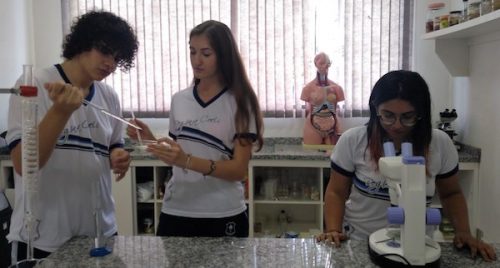
Students from Colégio Regina Coeli testing the development of lactobacilli in the presence of lactose – from left to right Eduardo Felipe Pagnan Vieira, Karine Gabriella Ascoli, Larissa de Oliveira Paes
Proposal Summary:
Lactose intolerance (a body’s inability to break down/digest the sugar in milk) is a world-scale issue that has been increasing exponentially over the last few years, affecting about 65% of the adult population, especially in European, African, and Middle Eastern countries according to the Global Lactase Persistence Association. With research being developed regarding the stay of astronauts under microgravity conditions – mainly aboard the International Space Station (ISS) – as well as the possibility of the colonization of Mars, it is essential that astronauts and future colonizers are in healthy conditions. This can only be achieved through a balanced diet and perfect nutrient absorption, so it is extremely important that future settlers and astronauts understand how the gut flora works. This project investigates the development of probiotic bacteria (Lactobacillus acidophilus and Lactobacillus bulgaricus), which are commonly used in the dairy industry, in microgravity. These bacteria are endogenous and actively participate in processes involving the gut flora, so any type of deficiency or delay in their development might result in difficulties to absorb nutrients. In conclusion, the research will observe the lactose break down under a microgravity environment, so that we can understand the relationship between gravity and the break down of this type of sugar.
HONORABLE MENTION FINALISTS:
Immuno-yeast in Space
Grade 9, Instituto Alpha Lumen
Co-Principal Investigators: Vinícius Augusto Landim de Andrade, Ana Beatriz Ribeiro Bruno
Co-Investigators: Matheus da Costa Justino, Mariana Pires Comune Biscuola
Collaborators: João Paulo Braga Correa, Gabrielly Fernanda Ribeiro de Oliveira
Teacher Facilitator: Juliana Alves Pires Biscuola
Proposal Summary:
Studies have shown that the immune system of living beings behaves differently in space due to the effect that microgravity has upon antibodies. It is known that for every 10 days in orbit, each crew member needs 15 days to recover their immune system. Therefore, the side effects of longer trips are still unknown, which prompts the need for studies about substances that are able to handle this issue in space. The biomass of yeast is a precious source of healthy proteins, lipids and polysaccharides for humans, animals and vegetables, due to the substances present in their cell walls. One of these substances is β-glucan, a polysaccharide that is able to effectively act as a modifier of immune responses, activating defense mechanisms, as well as being an antitumor, anti-inflammatory, antimutagenic, hypocholesterolemic, hypoglycemic polysaccharide that can protect us against infections. This polysaccharide corresponds to 40% to 60% of the yeast’s cell walls. But the question is: are there any changes on the composition of the yeast’s cell walls when cultivated under microgravity? Based on this, the following proposal intends to analyze the effects of microgravity on the growth of Saccharomyces cerevisiae yeast colonies, focusing on the changes of β-glucans in their cell walls. Determining if stress conditions generated by microgravity are capable of modifying the substances in microorganisms, making them less or more effective, opens doors for new studies and applications of useful solutions for an eventual interplanetary trip, especially in the field of health and nutrition.
Space Osmosis
Grades 11-12, Instituto Federal de Educação, Ciência e Tecnologia de Santa Catarina – Campus Florianópolis
Co-Principal Investigators: Eduardo da Costa Ilha, Pamela Fialho Silva Lopes de Oliveira, Tiago Ballmann de Campos, Vitor Fabre Zimmermann
Collaborator: Andrea Marrero
Teacher Facilitator: Paula Borges Monteiro
Proposal Summary:
This project consists on testing the process of osmosis under microgravity, based on how this process occurs under gravity. Osmosis as a daily process is intimately related to gravity, since the flow of substances through a semipermeable membrane happens in a cycle defined by gravity. Our experiment will use two volumes separated by a clamp. One of them will be filled with deionized distilled water, a semipermeable membrane and air. The other will contain copper sulfate pentahydrate, which is blueish in color. It is expected that, under microgravity, the flow of water through the membrane will be reduced. This hypothesis will be tested by unclamping the clamp and checking the volume of water that will remain with the sulfate by the end of the experiment. Our goal with this project is to verify the differences between the process of osmosis carried out in space and on land, enabling future experiments related to agriculture (plants’ roots absorb water and nutrient through osmosis) and gastronomy (crystallization of fruit, preservation of salted meat and fruit jams) to be conducted.
2. Edmonton, Alberta, Canada
Jump to Edmonton’s Community Profile
SELECTED FOR FLIGHT:
The Effect of Microgravity on the Early Development of Brine Shrimp Eggs
Grades 7 and 9, Highlands & Rosslyn Junior High
Principal Investigator: Sofia Sejutee
Collaborators: Adrien Hanna, Madison Keown, Bradley Vith
Teacher Facilitators: Sarah Graham, Alena Manera
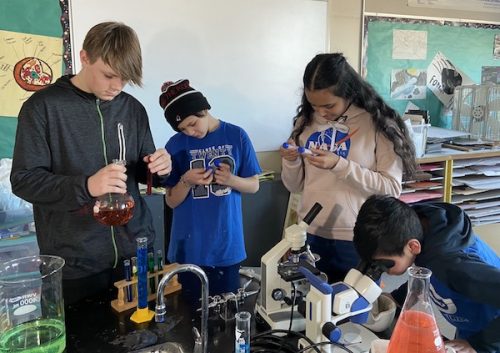
Students Researchers from Edmonton working on the selected flight experiment, the Effect of Microgravity on the Early Development of Brine Shrimp Eggs.
Proposal Summary:
The experiment will determine the effect of microgravity on the early development of brine shrimp. Brine shrimp are extremely resilient micro-crustaceans that can withstand harsh environments and varying salinity levels. During the early stages of development, the eggs can arrest as dehydrated cysts, and can be easily transported to space. To reactivate growth, saltwater is added. The timeline for growth and development is well suited to experimentation on the ISS. Brine shrimp are highly nutritious and full of protein, which make them a great food source for aquatic life such as fish. The Japanese Experiment Module on the ISS has an aquarium stocked with fish. Although this is mainly for studying the fish, if brine shrimp development is successful they can potentially be a sustainable food source for the fish, which can in turn feed astronauts on long term space missions. This will incorporate more vitamins, calcium, iron, zinc, potassium, and omega-3 fatty acids into the astronaut’s diets. Astronauts can also directly eat brine shrimp as it is rich in protein and omega-3 fatty acids. Brine shrimp can also be dried and made into a powder that can be taken as a nutritional supplement. Upon completion of the experiment, results will be analyzed under a microscope.
HONORABLE MENTION FINALISTS:
Does Microgravity Affect the Growth and Development of a Trichoplusia ni (Cabbage Looper)?
Grade 6, Elmwood School
Co-Principal Investigators: Jerrie Valdez, Hala Radwan, Maddie Holkema, Nora Shaldan
Teacher Facilitators: Lori-Anne Bond, Erin Kennedy
Proposal Summary:
This experiment will be investigating if microgravity will affect the growth and development of Trichoplusia ni (cabbage looper). The experiment is going to have multiple eggs in the FME tube (Type 1 Mini-Lab) on sterilized soil, with an artificial diet. This will help to ensure that the larvae have a food source that will support their growth. The investigation is going to test if they will hatch, grow or develop differently in microgravity compared to the gravity here on Earth. This experiment was chosen because moths can help pollinate and fertilize flowers and plants so they can produce fruits and seeds (DK Children, 2012). This will benefit astronauts on the space station, because if moths and butterflies can survive in space, then butterflies would be able to help produce fresh fruits and veggies instead of dried and canned food for the astronauts. If there is going to be a colony on Mars in the future, people would be able to have healthy food so they can stay healthy and active. Once the experiment is back on Earth, it will be compared to the ground truth experiment. Both experiments will be conducted at the same time to observe how many survived, do they look the same, are they in the same stage of their growth and development process and do they behave differently from one another.
How does Microgravity Affect the Memory Feature of the Metal Alloy Nitinol?
Grade 8, Michael Strembitsky School
Co-Principal Investigators: Jules Ng, Madison Symes
Teacher Facilitator: Julie Arsenault
Proposal Summary:
Our idea for Mission 14 involves the future of construction and medical practice in space. Our goal is to send a segment of Nitinol wire (nickel titanium) to space, bent at a 5° angle, to see if the effect of microgravity would change the memory feature of this alloy. Nickel titanium is a metal alloy that is designed to memorize a specific position and, when bent into a different shape, it can be heat activated to return to its original shape. This material, when in its remembered position, can be very strong and can withstand multiple different forces. Both of us will test the wire after being returned to Earth by measuring the speed and rate at which it reverts back to the original 180° angle that it started in. We believe that being in microgravity will affect the wire slightly because we know that if the composition of the alloy is changed at all, the wire will not be able to perform the same. The two of us are concerned that the microgravity may slightly deform the atoms, stopping it from being able to revert. We could use this material to boost our knowledge of materials for space. This material could be used to make emergency medical devices to ensure the astronauts of their safety in an emergency. It would be more cost efficient because of its lightweight and ability to fold and take up less room on the spacecraft. This could be the new generation of space materials.
3. Halifax, Nova Scotia, Canada
Jump to Halifax’s Community Profile
SELECTED FOR FLIGHT:
The Effects of Microgravity on an Activated Carbon Filtration System
Grade 9, Gorsebrook Junior High
Co-Principal Investigators: Eliana MacDonald, Katherine Scottie Sneddon-Simons, Rihanna Waligura-Newman
Teacher Facilitator: Sonja Goold
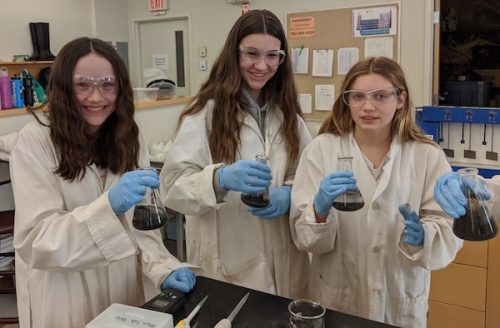
Students from Gorsebrook Junior High School examining granulated activated carbon mixtures at the Centre for Water and Resource Studies at Dalhousie University, Halifax, Nova Scotia.
Proposal Summary:
This experiment explores the effectiveness of activated carbon filtration systems in microgravity, by using the capillary process to collect the clean, drinkable water as well as the adsorption process of the activated carbon used to purify said water. This system will contribute to the knowledge and data necessary for living sustainably outside of Earth’s gravitational field. If proven effective, this will eliminate unnecessary transport of drinkable water to the ISS, and additionally, it will be extremely effective at purifying water when found outside of Earth. The supplies necessary for transport would be very lightweight, and could be used multiple times. Furthermore, we will be able to increase energy efficiency at the ISS by reusing water already on board.
HONORABLE MENTION FINALISTS:
The Effect of Microgravity on Developing Artemia salina
Grade 8, Gorsebrook Junior High
Principal Investigator: Audrey MacDonald Francis
Co-Investigators: Zella Pearse, Madison Sanford
Collaborators: Margaret Johnston, Milo van Kessel Power
Teacher Facilitator: Sonja Goold
Proposal Summary:
Artemia salina are crustaceans that live in salt waters around the world (sciencefriday.com). They are small in size, and can survive in very harsh conditions. The investigators will test the effect of microgravity on these organisms in this experiment. Their hypothesis is this: “If the bodies of astronauts that spend time in microgravity are negatively impacted by it, then A. salina when hatched in those same conditions would experience similar negative effects in their body’s development.” The experiment will go as follows: A. salina cysts will be hatched onboard the ISS in a FME mini-lab, and allowed to develop for roughly 2 weeks. They will then be preserved in formalin and returned to the investigators for analysis. The results of this experiment will give the investigators further insight into how developing organisms are impacted by microgravity environments.
The Effects of Microgravity on Nannochloropsis
Grade 8, Gorsebrook Junior High
Co-Principal Investigators: Willis Eddington, Alan Fawcett
Investigator: Sable Eddington
Collaborators: Elliot Curran, Liam Ewart
Teacher Facilitator: Sonja Goold
Proposal Summary:
Nannochloropsis algae has many uses, including its ability to be used as a renewable source of fuel, oxygen, and food, all of which are essential for life on earth, and would surely be profitable additions to spaceflight and space exploration. The team is proposing to send up Nannochloropsis algae in an FME mini lab so that it may experience the effects of microgravity, with the end goal of regrowing the algae to provide insight so a similar process could be used in the future to regrow algae aboard celestial bodies and open up the door to possibilities like space agriculture. Tasks like transporting large amounts of fuel to other planets could be accomplished by harvesting and producing fuel from algae aboard the celestial bodies, saving more essential materials for more important tasks like transporting masses through space. Algae can unlock the possibilities of the future, starting with the insight gained from the team’s experiment.
4. Winfield, Alabama
Jump to Winfield’s Community Profile
SELECTED FOR FLIGHT:
What are the Effects of Microgravity on the Germination of Aloe barbadensis Seeds?
Grade 6, Winfield Middle School
Co-Principal Investigators: Caroline Leigh Carothers, Avery Scott Lawler, Emma Grace South, Bella Claire Thompson, Anna Claire Tidwell
Teacher Facilitator: Ashley Seals
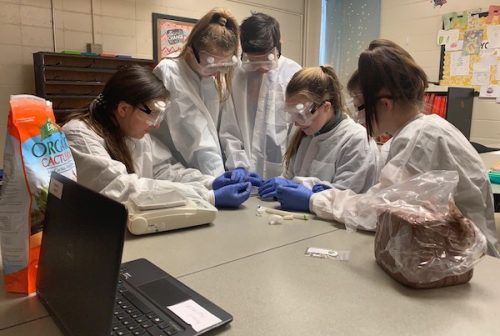
The Winfield City Schools team working on perfecting the measurements of soil and clay for their experiment What are the effects of microgravity on the termination of Aloe barbadensis seeds.
Proposal Summary:
What are the effects of microgravity on Aloe barbadensis? It is common knowledge that Aloe barbadensis can have a very positive effect on many different things. Possible space applications include using Aloe barbadensis to lower blood sugar, tightening skin, restoring muscles, healing burns and reducing dental plaque. The investigation will determine if Aloe barbadensis has the ability to germinate in microgravity, and what effects microgravity will have on the Aloe barbadensis that is trying to grow. If Aloe barbadensis has the ability to grow in space, then it can be used for a number of medical benefits. The leaves of an Aloe barbadensis plant contain slimy tissue that stores water. This gel is easily extracted for use in space, and contains the vitamins, minerals, amino acids and antioxidants in the plant.
HONORABLE MENTION FINALISTS:
Will Catharanthus roseus Seeds Germinate Better in a Microgravity or Gravity Environment?
Grade 8, Winfield Middle School
Co-Principal Investigators: Kaitlynn Lynn, Isaac Martine, Wes Estes, Autumn Porter
Teacher Facilitator: Bryan Kennedy
Proposal Summary:
We will be conducting an experiment on the germination of Catharanthus roseus (Madagascar periwinkle). We chose to do this experiment because of the big issue with radiation in space. Radiation has always been a risk to humans exploring space, but now that we are exploring deeper into space, it is becoming even bigger of an issue. The Madagascar periwinkle could help treat people if they are exposed to radiation and if they get cancer from it. Another reason we chose to do this experiment is because of the Madagascar periwinkle’s great medicinal properties. The Madagascar periwinkle is used for treating leukemia and preventing brain disorders. It can also be used to treat tonsillitis, Hodgkin’s disease, high blood pressure, inflammation, and other health problems. This plant could be very helpful for people on Earth, astronauts, or even when people live in space. When people live in space, another issue is that supplies will be very limited. There are billions of people living on the Earth, and if people were to live in space, then they would have to ration out all of their medicine, food, water, and etc. If the Madagascar periwinkle is used for medicine, then medicine would not be an issue because the Madagascar periwinkle is a rapidly growing plant and germinates in about one week.
Will Honey Bees Larvae Successfully Grow in Microgravity?
Grade 7, Winfield Middle School
Co-Principal Investigators: Charlee Kate Aldridge, Thomas Braxton Cunningham, Gracen Rooker Guin, Kennah Beth Lacy, Linnie Reese Hubbert, Everett Bravell Tilley IV
Teacher Facilitator: Freda Curd
Proposal Summary:
This experiment is based on honey bees. This experiment’s question is the following: Will honey bees’ larvae successfully grow in microgravity? Our hypothesis is honey bee larvae will successfully hatch and grow in microgravity. The species of honey bee that we are using is the Western honey bee (Apis millifera). It takes approximately 24 days for the bee to start its process of becoming a bee. We are going to send the eggs to Nanoracks, and on the way they will mature to larvae. By the time they get to the International Space Station, they will be a larvae. The reason we decided to do this is because honey bees are becoming a global concern. Dying bee hives are an issue and a huge risk to the pollination cycle. If bees successfully hatch faster in microgravity this will clear the global concern. This will clear the global concern because if bee hives grow faster in microgravity there would be less concern of them dying out of our ecosystem. Honey bees are very important in the every-day lifecycle. They balance out our ecosystem by pollinating plants. They heel all cut or open wounds and help with diabetes. The honey is used for natural flavoring in a lot of food items. Honey bees are a huge help to the pollination cycle. Honey bees need plants for food and plants need honey bees for pollination and that’s why we would appreciate the ability of being able to start colonies on Mars.
5. Buckeye, Arizona
Jump to Buckeye’s Community Profile
SELECTED FOR FLIGHT:
How will Microgravity Affect the Erosion and Durability of Teeth?
Grade 7, Steven R. Jasinski Elementary School
Co-Principal Investigators: Tatiana Caldera, Fabian Espinoza, Angelique Lugo, Jacob Ochoa
Teacher Facilitator: Holli Sierra
Proposal Summary:
The investigation compares the rates of erosion and reduced durability of teeth in microgravity, to those on Earth in the same conditions. Tooth erosion may be an issue in microgravity more so than on Earth. Dental care can rarely be provided in microgravity, leaving room for dental problems. Tooth erosion is the loss of dental enamel, which is a thin layer on the surface of the tooth made up of hard tissue. As the enamel begins to weaken, tooth erosion begins to occur. Certain beverages and acidic foods normally cause dental erosion, because they increase the acidity in your mouth as well as the bacteria that is housed in your mouth that forms acid. This experiment will be using lactic acid (the acid that is formed from bacteria exposure in the mouth) and phosphate buffered saline (acting as the base or buffer) as the elements to gauge microgravity’s effect on the erosion, durability, and density of teeth.
HONORABLE MENTION FINALISTS:
The Effects of Microgravity Regarding Tardigrades
Grade 8, Steven R. Jasinski Elementary School
Co-Principal Investigators: Emerson Hopps, Andrew Peters, Abbey Quezada, Nathaniel Tripp
Teacher Facilitator: Ryan Monahan
Proposal Summary:
The goal of this experiment is to discover the effects of microgravity regarding the lifestyle, reproduction, deterioration, feeding, et cetera of tardigrades. Tardigrades have been chosen as the specimen used in this experiment as they are unchallenging to care for, and capable of surviving nearly any complication that may arise. This experiment could benefit future missions by further examining the survivability of the interior of space crafts, meaning the likelihood of disasters occurring whence human kind is translocating to another celestial body will drop.
Spinacia Oleracea Seed Germination in Microgravity
Grade 7, Steven R. Jasinski Elementary School
Co-Principal Investigators: Neela Alvarez, Christian Berda, Arabella Floding, Maya Reyes
Teacher Facilitator: Holli Sierra
Proposal Summary:
The investigation of the project will be the effects of spinacia oleracea (spinach) seed germination in microgravity. The overall view of the project is to compare the difference between seed growth germination on Earth and in microgravity. This mission will be conducted to show that spinach can be a useful product/food/vitamin source for astronauts to use, grow, and potentially consume-in space. The principal objective of this experiment is to successfully show a further use for spinach, as well as advancing the understanding of the effects of microgravity on plants and seeds. The team behind this investigation decided to choose spinach, because it’s extremely high in minerals and vitamins, and it would be important in the health of astronauts and other space flight personnel. The experiment contains putting shredded coconut husk, spinacia oleracea seeds, distilled water, and a 10% Neutral Buffered Formalin solution in a type 3 FME Mini-lab. The experiment will involve using the coconut husk to retain moisture and allow the spinacia oleracea seeds to germinate, distilled water to start the process of germination and maintain crucial moisture, and 10% neutral buffered formalin to stop the germination process for examination back on Earth out of microgravity. At a congruent time, seeds will be germinating on Earth in similar conditions as in microgravity. Once the FME tube is returned to Earth, the germination results will be measured and compared to the ones on Earth. If they aren’t the same, it is concluded that microgravity affects spinach seed germination.
6. Corcoran, California
Jump to Corcoran’s Community Profile
SELECTED FOR FLIGHT:
Red Piranha Venus Flytrap Germination in Microgravity
Grade 7, John Muir Middle School
Co-Principal Investigators: Blake Cabral, Aaron Dias
Co-Investigators: Steven Amador Sandoval, Adrian Vazquez
Teacher Facilitator: Keylee Navarro
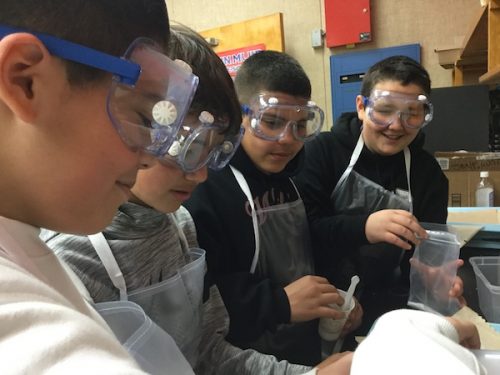
Mission 14 Scientists – Blake Cabral, Aaron Dias, Steven Amador Sandoval and Adrian Vasquez completing an experiment in science class.
Proposal Summary:
The investigation tests the ability of a challenging plant to grow, the Red Piranha Venus Flytrap plant, to germinate in microgravity. If Red Piranha Venus Flytrap can germinate in microgravity then other hard to germinate plants would most likely germinate as well. The investigation provides the Red Piranha Venus Flytrap seeds with rich soil and water to test germination. The experiment is stopped, with Formalin before returning to Earth. The results of the microgravity investigation are compared with an identical ground investigation to determine microgravity’s effect, providing scientific information for hard to germinate plants in space.
HONORABLE MENTION FINALISTS:
Germinating Radishes In Hydroponics
Grade 6, John Muir Middle School
Co-Principal Investigators: Raelie Luna, Beau Martinez
Co-Investigators: Rihannah Bravo, Jetta Ramos
Teacher Facilitator: Jazmin Ramirez
Proposal Summary:
Our group will be experimenting on radish seeds germinating in microgravity using hydroponics. The prediction is for the seed to germinate using hydroponics. We want to see if it’s faster and easier to grow more food in microgravity. Hydroponics is a method of growing plants without using soil. Hydroponics allows plants to be grown in its own way that the world can’t always provide. Hydroponics only uses water and a type of fertilizer for our experiment we are using liquid fertilizer. Hydroponics is an educational learning experiment to show that astronauts can grow fruits and veggies using water and no soil. From google, a radish seed can take 3-4 days or possibly up to 10 days to germinate. Our experiment wants to see if hydroponics is a possibility for astronauts and if the plant will germinate faster in microgravity. We feel that radishees are a useful plant to study because they have many benefits. They keep us hydrated and support a healthy heart. Radishes may keep your digestive system moving and give you a lower blood pressure. Radishes can detoxify your blood and give your immunity a boost and energy.
Beet Growth
Grade 6, John Muir Middle School
Co-Principal Investigators: Jesus Bravo, Issael Martinez
Co-Investigators: Emilo Franco Serrato, Angel Vera Mendez
Teacher Facilitator: Jayde Johnson
Proposal Summary:
The SSEP experiment proposed will be testing beet plant germination.The reason for this experiment is to test how the beet plant grows in space and how long of a germination period. The germination time of beets is 5 to 8 days and will need soil at a minimum of 50 F. (Healthline) Beets are easy to grow as they can germinate in partial sun. We want to determine if food can be grown in microgravity, to provide a continuing supply of food for astronauts as they venture farther into space when they go to mars. Beets are a healthy choice of food because beets are low in calories and a great source of nutrients, including fiber, folate and vitamin C. Beets also contain nitrates and pigments that may help lower blood pressure and improve athletic performance, both of these are important to astronauts (Healthline).
7. Moreno Valley, California
Jump to Moreno Valley’s Community Profile
SELECTED FOR FLIGHT:
Germination of Alfalfa in Microgravity
Grade 11, Canyon Springs High School
Co-Principal Investigators: Anthony Avina, Jadyn Roscelle Patos
Co-Investigators: Hannah Caswell, Jason Ng
Teacher Facilitators: Sharon Scott, Divina Elbo
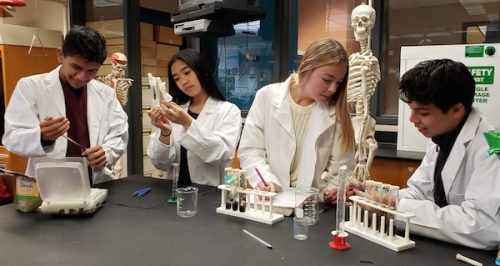
Preparation and testing have begun for the final flight experiment: Germination of Alfalfa in Microgravity. Students in order left to right: Anthony Avina, Jadyn Patos, Hannah Caswell, & Jason Ng
Proposal Summary:
If NASA attempted to form colonies beyond Earth’s boundaries, whether it be on moons, planets, or space stations many challenges would be encountered when trying to sustain life, including lack of food reliability. One extremely versatile and valuable source of food is alfalfa. Alfalfa is an excellent source of calcium, which is beneficial to astronauts because of bone loss resulting from microgravity. Alfalfa also provides a large variety of vitamins and minerals, which can be very limited in an astronaut’s diet. This experiment expands upon a previous SSEP experiment by studying not only germination, but also the alfalfa’s viability in the nitrogen cycle. Alfalfa, a cost-effective and easily obtained legume, contributes to the nitrogen cycle, which can be used in space agriculture to replenish soil for other crops. It can do this by forming root nodules, which have a symbiotic relationship with rhizobium bacteria. Additionally, as a producer and autotroph, it can be used as part of the food chain to feed both primary and secondary consumers. Alfalfa is a desirable choice for this experiment because it is palatable to humans. It takes as little as two days to germinate, 10 days to form nodules, 40 days to fully mature, and it can be dried and stored indefinitely under proper conditions. In addition, alfalfa can be grown hydroponically. Due to the previously mentioned attributes, the effects of microgravity on alfalfa growth will be investigated to determine if it is able to sustain a place in an interstellar food chain. The team hypothesizes that the experiment in microgravity will have relatively few differences from the ground experiment, including root size, the rate of growth, and nodulation.
HONORABLE MENTION FINALISTS:
Mealworm Development in Microgravity
Grade 11, Valley View High School
Co-Principal Investigators: Iylene Ballesteros, Vincente Hayes, Angela Macias
Teacher Facilitator: Stacy Katzenstein
Proposal Summary:
This experiment involves the growth and development of mealworms to explore the ways microgravity will affect their development from egg to larva, to pupa, and finally Darkling Beetle. Going into this experiment it was initially planned to conduct a life-based experiment. Spanning through many experimental specimen options which, included brine shrimp, various species of spiders, tadpoles, and cockroaches; unfortunately, these prior experiments did not follow the SSEP student spaceflight guidelines, mainly due to the space limitations of the Fluid Mixing Enclosure. Which would eventually, lead to settling upon experimenting with mealworms because they conformed with the requirements and limits given by the SSEP guidelines. With that said, these creatures are very important and necessary to the ecosystem, as they help with the decomposition and clean up of unwanted organic matter. Mealworms can also be a nutritious source of food and are fairly easy to breed and not very expensive. There are even cultures such as those which reside in Asia, more specifically, South-East Asia which consume insects such as mealworms casually. Even if Mealworms didn´t prove to be an appealing food source for astronauts alone, they could also serve as a feed for livestock upon colonizing other planets or microgravity environments. If the experiment involving mealworm growth in microgravity is successful and the mealworms fully develop, it then demonstrates that mealworms can be a viable organism to help maintain the health of an ecosystem, as they play a huge role in decomposition, and serve as a possible-reliable food source for astronauts and livestock alike when occupying microgravity environments or uncolonized planets.
Bacteria Process in Microgravity Interacting with Milk
Grades 11-12, Canyon Springs High School
Co-Principal Investigators: Joshua Bennett, Francesca Blanco, Darren Manalo, Kira Shimamura
Teacher Facilitators: Sharon Scott, Divina Elbo
Proposal Summary:
Yogurt is a nutritious food source that is developed with the use of bacteria and milk. By finding out if microgravity will have an effect on the processing of lactobacillus acidophilus in powdered milk for the formation of yogurt, one could potentially start making yogurt, or a version of it in space for a health food source. Rather than relying on freeze-dried food for substance, the nutritional value in yogurt could be provided as an alternate food source. The nutritional value of yogurt would also be beneficial to the diets of astronauts suffering from microgravity-caused ailments. Yogurt is a relatively abundant source of protein and calcium, which can provide help with the various problems astronauts may face while in microgravity. It has a longer shelf-life than milk and it is also quite easy to produce yogurt, given that the materials are provided. The process of using lactobacillus acidophilus to make yogurt could provide potential benefits. The experiment with the lactobacillus acidophilus would be used as a frame of reference for other bacteria in microgravity. Any phenomena observed as a result of the microgravity environment could be applied to different strains, serving as a benchmark for various experiments. Other possibilities could include research and medical benefits that yogurt can provide to humans in space environment such as bone health (Ware, 2018). Further testing of space-made food could result from the experiment. Overall, the experiment of observing bacterial processes in microgravity could expand scientific knowledge for further reference.
8. Redlands, California
Jump to Redlands’ Community Profile
SELECTED FOR FLIGHT:
Microgravity’s Effect on the Germination and Early Growth of the Seeds of Cymbopogon citratus
Grades 10-11, Redlands High School
Principal Investigator: Maximilian Floridia
Co-Investigators: Evan Kusko, Ayesha Mirza, Anna Nguyen
Teacher Facilitator: Paul N. DeVoe
Proposal Summary:
This experiment assesses the effect of microgravity on the germination and early growth of the seeds of Cymbopogon citratus (the scientific name for lemongrass). Specific factors assessed are radicle orientation, germination rate, and root length. Not only will this help to validate and elaborate upon prior conclusions regarding the effect of microgravity on seed germination and early growth, but the results may also be analyzed to discern whether lemongrass overall is a viable plant in microgravity. Discussed extensively in both scientific and popular sources, lemongrass seeds and the mature plant itself are hardy, easy to grow, and tolerant to various adverse conditions, indicating that Cymbopogon citratus may be an economically logical plant to cultivate in the outer space environment. Additionally, researchers have demonstrated that its medicinal and practical applications are numerous, assuming important positions in the spheres of pharmacology and aromatherapy. These benefits become more attractive when the difficult conditions astronauts frequently encounter in microgravity are considered, with lemongrass potentially serving as a valuable resource for aiding the immune system, relieving psychological stress, and achieving necessary sanitation.
HONORABLE MENTION FINALISTS:
An Investigation on the Role of Inhibitory Adjuvants in a Microgravity Environment: Suppression of β-lactamase in Staphylococcus epidermidis with Acquired Antibiotic Resistance via Amoxicillin Clavulanate for Spaceflight Medical Therapy
Grades 10-11, Redlands High School
Co-Principal Investigators: Sanjana Fernando, Akansha Magal, William Porayouw, Diya Theodore
Teacher Facilitator: Paul N. DeVoe
Proposal Summary:
A principal concern within spaceflight organizations is providing an effective treatment plan for combating medical illnesses arising from bacteria with acquired resistance due to prolonged exposure to a microgravity environment. This proposal seeks to investigate the efficacy of inhibitory adjuvants in order to achieve antibacterial drug optimization against such threats. While inhibitory adjuvants have proven to be effective supplements for antibiotic medication on Earth, their performance in space remains relatively unexplored. The proposed experiment focuses on the production of the β-lactamase enzyme in Staphylococcus epidermidis in microgravity as it reacts to the β-lactam adjuvant drug clavulanic acid in conjunction with the antibiotic Amoxicillin. β-lactamase is a resistance determinant that reduces the effectiveness of antibiotics, and therefore its inhibition would improve quality of life in astronauts. If clavulanic acid is found to be successful in significantly diminishing the concentration of β-lactamase in S. epidermidis, inhibitory adjuvants should be further researched as potential candidates for an alternative approach to combating increased antibiotic resistance in microgravity.
Effects of Microgravity on Chlorella Cultivation
Grade 9, Redlands High School
Co-Principal Investigators: Eric Chen, Christopher Pham, Varun Srivastava, Dexter Xu
Teacher Facilitator: Paul N. DeVoe
Proposal Summary:
Chlorella is a green algae that grows in freshwater and is used to create nutritional supplements for humans. Chlorella also absorbs carbon dioxide and releases oxygen. Chlorella is very nutritious and has been used as a supplement for centuries. The proposed experiment aims to determine whether Chlorella can be cultivated in space to provide nutritional supplements to astronauts on long-term space missions and produce oxygen in the spacecraft. NASA’s Twins Study has established that space travel causes changes to muscle atrophy, reduces bone density, and deteriorates vision, and the effects on astronauts would be greater on long-term space missions. If Chlorella can be cultivated on spacecrafts, it could be a nutritional supplement that astronauts could take to overcome the effects of microgravity and stay fit on long space missions. In addition, Chlorella could be used to recycle the carbon dioxide produced by the astronauts on the spacecraft and release oxygen. If the growth rate of Chlorella in space is equal or greater than the growth rate on Earth, the amount of Chlorella that would have to be grown to sustain astronauts in space can be determined. If the growth rate slows, then it would not be practical to cultivate Chlorella in space. In that case, other algae could be tested
9. Stamford, Connecticut
Jump to Stamford’s Community Profile
SELECTED FOR FLIGHT:
The Effect of Microgravity on the Ability of Galloflavin, in the Absence of Membrane Based Cellular Signaling Pathways, to Inhibit the Enzymatic Activity of Lactate Dehydrogenase A
Grade 12, Stamford High School
Co-Principal Investigators: Rithin Armstrong, Lizet Garcia
Teacher Facilitator: Sue Dougherty
Proposal Summary:
The investigation analyzes the inhibitory effect of Galloflavin on the tetrameric enzyme, Lactate Dehydrogenase A. Cellular respiration in humans is comprised of glycolysis, acetyl coenzyme A formation, the citric acid cycle, and oxidative phosphorylation. In aerobic conditions, cancer cells prefer metabolism via glycolysis rather than oxidative phosphorylation, which is the preference of most other cells of the body. This phenomenon is known as the Warburg Effect. Glycolysis is fueled by the nicotinamide adenine dinucleotide + obtained from the fermentation of pyruvate to lactate. Lactate dehydrogenase, the enzyme that catalyzes the conversion of pyruvate to lactate, plays an immense role in the processes leading to glycolysis and regulates the Warburg Effect. By inhibiting the enzymatic activity of Lactate Dehydrogenase A, we can disrupt aerobic glycolysis and decrease cell viability effectively across many cancer cell types. The investigation analyzes the effect of microgravity on the ability of Galloflavin, a lactate dehydrogenase inhibitor, to impair aerobic glycolysis and as a result inhibit the growth of cancer cells. Galloflavin has proven to inhibit the growth of endometrial cancer cells on Earth, however, very little is known about how Galloflavin and other potential inhibitors react in microgravity. Understanding the reactivity of these inhibitors in an acellular aerobic solution, in a microgravity environment, could be key to understanding more about whether Galloflavin’s potential effectiveness is independent of membrane based cell signaling pathways.
HONORABLE MENTION FINALISTS:
The Effect of Microgravity on the Production of Amino Acids from C. glutamicum
Grade 11, Stamford High School
Co-Principal Investigators: Neisha Boiteux, Shaina Bond, Prisha Kulkarni, Rakshita Ramakrishna, Rachana Somaskandan
Teacher Facilitator: Sue Dougherty
Proposal Summary:
Our mission seeks to analyze the effects that microgravity has on the production of L-amino acids from the bacteria Corynebacterium glutamicum. This bacterium produces L-amino acids through the passage of a carbon source through its central metabolic pathways. Degradation reactions take place inside the cell during this process to prioritize the secretion of certain amino acids over others. On Earth, the fermentation of C. glutamicum results in the production of most of the essential amino acids that are necessary for bodily functions. Conditions that are considered as factors affecting this process are pH levels, oxygen, and stirring. During the experiment, the Type 3 FME Mini-Lab will contain C. glutamicum, a rehydrating broth for the bacteria, and an aqueous potassium nitrate solution and a glucose solution. There will also be a control experiment that will be conducted on Earth for comparison. When the mini-lab comes back from the International Space Station (ISS), the results will be examined to analyze how the micro-gravitational environment affected the amount of L-amino acids produced. L-amino acids are vital for processes such as the building of proteins and synthesis of hormones and neurotransmitters. Amino acids are the building blocks of protein and our experiment will investigate the possibility of production of them in space. Without proper oxygen, C. glutamicum cannot produce a sufficient amount of amino acids. Through this experiment, we will determine if C. glutamicum can still produce amino acids in a gravity-deficient environment and whether space could be suitable for mass production.
Efficacy of Escherichia coli K-12 in Space
Grade 11, Stamford High School
Co-Principal Investigators: John Falger, Panos Ketonis, Siddharth Kumar, Diana Vukel, Edward Yudolevich
Teacher Facilitator: Sue Dougherty
Proposal Summary:
Bacterial antibiotic resistance has become a considerable topic in the medical field, but hasn’t been thoroughly studied in space. Our experiment will observe the effects of microgravity and radiation on the development of antibiotic resistance in E. coli K-12 bacteria. Antibiotic resistance commonly develops in two ways: mutation (where bacteria that randomly develop the resistance gene survive and reproduce), and lateral gene transfer (where bacteria share DNA). It has previously been established that bacteria replicate at the same speed in space as they do on Earth, allowing us to isolate the rate of mutation and lateral gene transfer as the only factors affecting the bacteria’s ability to become antibiotic-resistant. In our lab, Ciprofloxacin (an antibiotic commonly used to treat E. coli) will be introduced into the system. This antibiotic resembles a real world stressed environment, in which bacteria are being treated with medical inhibitors. This, in concurrence with the radiation and microgravity environment, should affect the rates of mutation and lateral gene transfer in the system. Comparing the proportions of antibiotic resistant and non-antibiotic resistant bacteria in the ground truth to the space flown sample, will allow us to conclude how space has affected the bacteria. We will also be able to observe any changes in the viability of the bacteria (damage to DNA/organelles or total cell failure). The results of our experiment will give mankind a better understanding of how bacterial infections should be fought in space and allow future space travelers to be better prepared.
10. Hillsborough County, Florida
Jump to Hillsborough County’s Community Profile
SELECTED FOR FLIGHT:
Spinach on the Station
Grades 7-8, Randall Middle School
Co-Principal Investigators: Grace Kalnins, Lucas McMillin
Teacher Facilitator: Mary Vaughn
Proposal Summary
The investigation will determine the frequency rate of the germination of Giant Noble Spinach in microgravity. The justification for this is so humans can go forward to the Moon and onto Mars with a constant food source that is nutritious and healthy. Spinach is easy to grow, rich in vitamins, trace minerals, protein, and fiber. Research has shown that astronauts need food that is high in nutrients because unlike Earth’s environment, space causes stressors on the human body. For example, astronauts’ muscles weaken because of microgravity, so to counter this, exercise is required daily to keep muscles in shape. Since astronauts aren’t on Earth, they may not be eating fresh, nutritious foods. Fresh spinach has more nutrients than prepackaged spinach that astronauts are currently eating. Researchers predict that fifty percent of the seeds will germinate. The advantages of growing spinach in space would allow for astronauts to maintain longer duration missions and to sustain a healthier presence in space.
HONORABLE MENTION FINALISTS:
Carrots in the Cosmos
Grade 6, Randall Middle School
Co-Principal Investigators: Peter Alamia, Armani Njogu, Emmie Poirier, Haden Smith
Teacher Facilitator: Mary Vaughn
Proposal Summary:
The team proposes to send Danvers Half Long carrots to the International Space Station in a FME 3 Mini Lab. The crew is proposing this experiment because it could provide food for the astronauts on long duration missions to other planets or the Moon. The team is trying to answer the question “How does microgravity effect the germination of a Danvers Half Long Carrot seed?” The independent variable of this experiment is microgravity and the dependent variable is the seed growth of the Danvers Half Long carrot. The seeds need to sprout in microgravity to determine if they are a viable food source for future missions. If the carrots germinate well, then they can be a great food source for astronauts. If they don’t germinate, then the astronauts will know that carrots should not be grown during long duration missions. This experiment should be selected for flight because healthy food is needed aboard rockets to other celestial bodies. Since carrots have antioxidants, fibers, Vitamin K1, and potassium they would be a healthy vegetable to keep astronauts’ bones and organs strong while in microgravity. Carrots are also good for eyesight, so astronauts get another benefit by eating carrots on the ISS. Overall this information should provide the basic understanding of why this experiment should be selected to go to the International Space Station and benefit astronauts’ journey to other planets and to the Moon.
When Peas Fly
Grade 6, Randall Middle School
Co-Principal Investigators: Francesca Best, Saven Burgos
Teacher Facilitator: Mary Vaughn
Proposal Summary:
The team, When Peas Fly, is proposing an experiment on if peas can grow in microgravity. Our team wants to grow peas in microgravity because they know peas can germinate without any soil. According to their trials, the peas are able to germinate on felt and the bottom of a bin. The peas were watered every other day and germinated quickly. Peas should be tested because they have a lot of nutrients and vitamins astronauts need. For instance, carbohydrates, fiber, protein, vitamins A, K, C, and Iron can be found in peas. Alaskan peas have many benefits that will keep the human body healthy. For example they are great for your eyes and they help regulate blood sugar. The group has determined that the experiment will work because Alaskan peas sprout within 1 to 2 weeks. Peas can help with digestion and help keep your skin healthy. The pea team knows that astronauts are introduced to radiation which can affect astronauts’ health in many ways. For example, astronauts can get radiation sickness, risk of getting cancer, central nervous system effects, and diseases from being in space. Peas can help deflect diseases, so they can keep your body healthy. The team knows that Alaskan peas are another viable food astronauts can eat to help their immune system, help deflect diseases, and help blood sugar regulation. Alaskan peas benefit astronauts and are very simple to grow. This is why the pea group believes that peas should be tested for growth in microgravity.
11. Pasco County, Florida
Jump to Pasco County’s Community Profile
SELECTED FOR FLIGHT:
How will Microgravity Affect the Efficiency of Amoxicillin on S. Epidermidis?
Grade 12, Wendell Krinn Technical High School
Co-Principal Investigators: Amanda Marrero, Shelly Nonnenberg, Emily Null
Teacher Facilitator: Sarah Kumar
Proposal Summary:
Research on Staphylococcus aureus in microgravity is imperative for the welfare of astronauts. S. aureus is a gram-positive bacterium found in the International Space Station, in human nasal passages and on skin. The effects of S. aureus can cause anything from minor skin infections to life-threatening diseases such as boils, pneumonia, meningitis, or sepsis (“Staphylococcal”). In place of S. aureus, Staphylococcus epidermidis will be used in this experiment because it is a biosafety level 1 organism, which is non-pathogenic and safer for astronauts to use as well as being structurally similar to S. aureus. Amoxicillin is a beta-lactam antibiotic that is used against S. aureus. This experiment is to determine the effectiveness of Amoxicillin in microgravity. Without this data, astronauts are at risk of with infections that are difficult to treat by other means and may prevent them from recovering properly.
HONORABLE MENTION FINALISTS:
Effects of Microgravity on Armillaria mellea Decomposition Properties
Grade 12, Wendell Krinn Technical High School
Co-Principal Investigators: Yazmene Canty, Kindra Dean, Angelina Mira
Teacher Facilitator: Sarah Kumar
Proposal Summary:
This investigation will show how microgravity can affect the growth of Armillaria mellea (Honey Mushrooms) to understand the resulting decomposition from the organism. Knowing how microgravity changes the decomposition rate can provide a greater understanding on how to grow them in space without specially needed chambers and allow for species to decompose naturally in microgravity. These mushrooms can take away the concern of the availability of fresh soil and nutrients on any planet. Honey mushrooms have Mycelial cords, which are black stringy tendrils that are made of fungal cells. This structure helps mushrooms channel nutrients and leave white rot. White rot is what they use to break down lignin, the cell wall that makes plants rigid, and allow mushrooms to extract nutrients. The mushrooms are bioluminescent but only their gills glow. The gills of a mushroom are located under the mushroom cap (Honey Fungus Mushroom). This structure helps provide light in pitch dark situations. Each of these properties of A .mellea could help improve the chances of survival on another planet or environment by creating natural and nutrient rich soil along with decomposing waste as it’s produced (Shea, S. B. Behind the Scenes).
The Effects of Microgravity on Yeast Fermentation
Grade 9, Wendell Krinn Technical High School
Principal Investigator: Joshua Mark
Co-Investigators: Paul Archer, Shiana McGuire
Collaborator: Emily Coleman
Teacher Facilitator: Kathryn Ward
Proposal Summary:
This experiment seeks to determine how well yeast colonies will utilize sugar in order to produce energy in microgravity conditions at the International Space Station. This will be measured by examining carbon dioxide output of Baker’s yeast, also known as Schizosaccharomyces pombe, in both the ground and the space experiment. Scientists can apply the results of this experiment to the production and growth of other organisms in space such as fungi. The results of this experiment could provide more insight into how yeast and other fungi operate. Also, the potential growth of such fungi would be helpful or living in space, as edible fungi could be utilized to sustain astronauts on the International Space Station. Overall, this experiment is a notable contribution to science and should be used on the International Space Station.
12. Anne Arundel County, Maryland
Jump to Anne Arundel County’s Community Profile
SELECTED FOR FLIGHT:
How does Microgravity Impact the Germination of Thyme
Grade 7, Central Middle School
Co-Principal Investigators: Abigail Ippolito, Ella Lovelace
Co-Investigators: Mary-Cate Parks, Natalie Wolf
Teacher Facilitator: Margaret Sieber

Student researchers from Central Middle School in Edgewater, MD refining their experiment to test the effects of microgravity on the germination of Thyme seeds.
Proposal Summary:
How does microgravity impact the germination of thyme? Microgravity can change the growth of roots due to the lack of gravity pulling the roots down towards the Earth. Growing thyme in microgravity is important to test because of the number of uses thyme has, including alleviating an upset stomach, and killing fungi and bacteria naturally. A thyme plant generally takes 6-12 days to germinate. For the project, it might take a little longer since the conditions in the mini-lab are not optimal. In this project, the ISS crew initiates germination on station to determine how microgravity affects the germination of thyme seeds, and how it changes the ideal plant structure.
HONORABLE MENTION FINALISTS:
Lima Bean Seeds (Phaseolus lunatus) in Microgravity
Grade 7, Central Middle School
Co-Principal Investigators: Bridget Long, Finn Mulvihill
Co-Investigators: Tyrell Davis, Raegan Ogle
Teacher Facilitator: Mary Doran Brown
Proposal Summary:
Our proposal title is “Lima Bean Seeds (Phaseolus lunatus) in Microgravity”. We are testing the effects of microgravity on the germination and growth of two lima bean seeds (Phaseolus lunatus). Our experiment will be set up as a type two FME Mini-lab (2 experiment volumes: one clamp used). There will be two lima bean seeds (Phaseolus lunatus) in the silicone tube and a clamp separating the two seeds. Inside each section there will be a small (2cm by 2cm) piece of damp paper towel. Then, the crew will wait. We are hoping to figure out if a lima bean seed (Phaseolus lunatus) can germinate and grow in microgravity. We would like to learn this, because lima beans (Phaseolus lunatus) could become a food source for astronauts. When we researched the health benefits of lima beans (Phaseolus lunatus), we found out that “Lima beans are packed with a wide range of minerals and trace elements including iron, magnesium, phosphorus, potassium, copper, and manganese…” We believe that this is an important aspect to our proposal because it explains why we have chosen to do our proposal on lima bean seeds (Phaseolus lunatus).
Oxidation of Rust in Microgravity
Grade 7, Central Middle School
Co-Principal Investigators: Nazeer Ahmed, John Bertuna
Co-Investigators: Connor Feldmann, Jayden Paige
Collaborator: Jaden Abereoje
Teacher Facilitator: Margaret Sieber
Proposal Summary:
We want to look forward in time, and focus on issues that might impact humans in the future. This is the goal of our experiment. We want to figure out how microgravity affects the physical and chemical properties of iron filings in the oxidation process. We think this will be a good topic to test. We believe this because if we eventually colonize planets like Mars, or the Moon, we will need inexpensive and abundant resources that we can rely on to build with. If iron will rust and weaken, we can eliminate the possibility of building with steel on Mars. But, if the iron doesn’t rust, steel can be a possible building material in space in the near future. We will be using iron filings for our experiment, because they are light and powdery, while also fitting within the FME tube. In one of our sections of the type 3 FME mini lab, we will be using distilled water to replicate the oxidation process. We will put the Iron filings in the middle section of our tube, and in the bottom section there will be nothing so that there is more space for Oxygen to help the rusting. When our tube comes back down to Earth from the ISS, we will observe the physical and chemical changes through a school property microscope and compare to our results on Earth. We hope that this experiment can give us more insight on how we can use resources in Space.
13. University System of Maryland, Maryland
Jump to University System of Maryland’s Community Profile
SELECTED FOR FLIGHT:
The Effect of Microgravity on Bacteriophage Replication and Infectivity
(Part II to Mission 12 Flight Experiment)
Grades 13-14, University of Maryland, College Park
Co-Principal Investigators: Sabrina Dineshkumar, Aaron Kong, Jiatong Liang, Asad Rizvi
Teacher Facilitator: Natalia Stepanova
Proposal Summary:
Aboard the ISS, low gravitational pull, radiation from cosmic rays, and lack of ventilation are some of the many factors that lead to a greater rate of bacterial mutations, such as increased metabolic activity and antibiotic resistance, as compared to on Earth. This phenomenon introduces risk for greater bacterial exposure to astronauts and it is important that the ISS maintains advanced methodologies for sanitation that can combat even the most adapted bacterial strains. As an alternative to traditional sterility methods, such as alcohol or UV irradiation, in recent years, bacteriophages have re-emerged as potential use against bacteria. The introduction of bacteriophage sterilization could create an alternative for not only disinfection on the ISS, but for further and even more developed uses for bacterial infections (i.e. antibiotic substitutes). Bacteriophages are a type of virus that infect and destroy targeted bacteria from within cells, while remaining harmless to humans. Their versatility could be greatly explored, as proposed in this experiment design. This project will ultimately focus on analyzing the rates of mutations and the effects of microgravity on T4 bacteriophage infectivity. Gene expression changes will be observed through polymerase chain reaction (PCR) amplification and sequencing, particularly expression of the phage infection lytic enzymes. In an increased phage infectivity rate, the T4 bacteriophage could provide an effective and environmentally friendly sterilization alternative to the traditional disinfectants used today. With further research and experimentation, bacteriophages could be used as sterilization agents and directly applied on surfaces via spraying or as wet wipes.
HONORABLE MENTION FINALISTS:
The Effect of Microgravity on the Recellularization of an Extracellular Matrix Scaffold
Grade 14, University of Maryland, College Park
Co-Principal Investigators: Kaaran Chopra, Diksura Dissnayake, Rachata Jatabut, Sunghun Jeong, Paolo Lami, Christopher Regan
Teacher Facilitator: Dr. Daniel Serrano
Proposal Summary:
The 21st century has seen a great deal of advancements in tissue engineering, ranging from 3D bioprinting of organs to artificial cell-based regeneration of tissues. Previous research has shown that microgravity conditions cause significant mechanical unloading to human tissues, leading to long-term tissue regenerative health damage [1]. Thus, understanding how well tissue regeneration occurs in space will both be beneficial to the astronauts’ well-being and allow for further advancements in regenerative medicine. This makes it important to understand the extent of the effects of microgravity on the extracellular matrix (ECM) components of the tissue and whether it impacts the adhesiveness and effectiveness of cell regeneration. Acellular human tissue scaffolds are a new tool for studying recellularization and tissue reparation. Experiments on Earth have demonstrated the viability of cellular regeneration on a tissue that has been decellularized, a process where cells are removed from the tissue/organ, while still retaining all essential cues for cell survival in the organ structure and its extracellular matrix components. To solve the concerns related to current regenerative medicine, it is important to analyze tissue engineering across three elements: cells, growth factors, and scaffold. The interactions among these three elements control the process of tissue regeneration [2]. Our experiment would simulate this process by utilizing cell-mimicking microparticles coated with integrin beta-1 and seeding them onto a decellularized tissue scaffold. These microparticles will mimic living cells binding to a decellularized placenta tissue, allowing us to explore cellular adhesiveness in space.
Phenotypic Changes Exhibited by Gut Microbiota, Faecalibacterium in Space
Grades 13 and 15, University of Maryland, College Park
Co-Principal Investigators: Ethan Hoffman, Raneem Megahed
Teacher Facilitator: Dr. Kenneth Frauwirth
Proposal Summary:
Human space presence is increasing at an unprecedented rate. For nearly twenty years, humans have maintained a constant presence over the planet’s atmosphere, with six currently aboard the International Space Station (ISS), while private companies like Virgin Galactic or Amazon’s Blue Origin will increase the amount of humans in space with their promise of space-tourism in the incredibly proximate future . Within every human is vast amounts of microbes in their gut. This gut microbiota plays a pivotal role in nutrient metabolism and the immune system. Populating over 5% of gut microbiota, Faecalibacterium is the most abundant gut bacteria. This anaerobe bacterium functions as a vital regulator for gut immunity and inflammation. Unbalanced quantities of Faecalibacterium are association with Crohn’s disease, obesity, psoriasis, and even depression. It is widely known that microgravity and cosmic radiation from space may significantly impact microbial phenotypes, for example, dramatically decreasing or increasing cell count, yet how Faecalibacterium interacts with this environment has not been studied. Investigating the effects space has on the phenotype of Faecalibacterium is important to understanding how the human gut will experience these environments. The results of such a study may help astronauts appropriately alter their diet in order to balance their levels of Faecalibacterium or for those with aforementioned Faecalibacterium associated complications take proper precautions before traveling to space.
14. Westford, Massachusetts
Jump to Westford’s Community Profile
SELECTED FOR FLIGHT:
How does Brassica napus (rapeseed) Germinate in Microgravity?
Grade 6, Stony Brook School
Co-Principal Investigators: Erin Cassidy, Makayla Cassie, Anvita Damera, Grace Hinkle, Hradini Shinde
Teacher Facilitators: Jennifer Masterson, Sandra Femino
Proposal Summary:
How will Brassica napus (Common name: rapeseed) will germinate in microgravity? The rapeseed plant can be used for many different edible and non-edible purposes. Rapeseed oil can be used for biodegradable soft plastics, biodiesel, soap, lamp fuel and hydraulic fluids. The rapeseed plant’s biodegradable projects and biodiesel can help astronauts in microgravity because it will make less air and water pollution in a possible colonization in space.
HONORABLE MENTION FINALISTS:
Mung Beans in Space
Grade 7, Stony Brook School
Co-Principal Investigators: Elizabeth K. Bellomy, Antony S. Khvesiuk, Nate J. Li, Keene J. Park, Brian A. Podolskiy
Teacher Facilitators: Amity Baldwin, Joseph Barnas
Proposal Summary:
The question our group is focusing on is, “How does a plant growing in space without the use of geotaxis perform against a plant on Earth that does have the assistance of geotaxis?” We decided to focus on geotaxis, the method plants use to position themselves through gravity, because if we can efficiently grow plants in space, then astronauts and scientists that go up to the International Space Station would have a healthier food option then freeze-dried foods. Sustainable food growth is almost required for longer journeys in space. The plants that we are testing are mung beans (Vigna radiata), which are an excellent source of protein, vitamin B, dietary fiber, and research has shown that beans can help reduce blood sugar and improve ones cholesterol levels. These beans could be the first step to growing a variety of fruits and vegetables. Such fruits and vegetables would provide scientists an excellent source of vitamins, minerals, and potassium. An adequate amount of plant-based foods would also prevent constipation and other digestive problems, reduce the risk of health diseases, high blood pressure, stroke and some cancers. Another reason to eat fruits and vegetables is that it will help decrease bone loss as one ages, and it will help form red blood cells. In all, growing plants in space would be a huge bonus for scientists, and might also be vital for the fast-approaching journey to Mars. Also we are running out of land for farming on earth so being able to farm in space would also help with that.
Can Lavender Germinate in Microgravity?
Grade 6, Stony Brook School
Principal Investigator: Julia Zhou
Investigator: Josephine Hoyt
Collaborators: Edward Hibour, Ganajit Bhat
Teacher Facilitator: Jennifer Twitchell
Proposal Summary:
For our experiment, we want to send lavender seeds up to the International Space Station (ISS) to see how microgravity affects the germination and growth of English lavender (lavandula angustifolia) seeds. Through our research, we discovered that lavender has medicinal properties, so if it is possible to germinate the seeds, then the scientists aboard the ISS would be able to grow their own medicine! Scientists and doctors have researched that lavender can help with anxiety, restlessness, insomnia, as well as nausea, which the astronauts in the ISS tend to suffer from. Since lavender makes the muscles relax and slows down your heart rate, then it will soothe the astronauts. Astronauts can also use lavender to brew herbal tea, and they can also put some dried lavender sprigs in their pillowcases to help them sleep. Once the lavender is flowering, the flowers can be crushed to create lavender essential oil, which in turn, can be used to ease and calm the astronauts. The English lavender (lavandula angustifolia) seeds on Earth and in space will get an equal amount of water, air, and light. They will also be grown in the same soil, and the same Type 3 FME tube. The only difference will be that one group of seeds are germinating and growing in microgravity, and the other in gravity. When the tube from the ISS returns, we will be measuring how much the seeds grew and how long they took to germinate in microgravity compared to gravity.
15. Harper Woods, Michigan
Jump to Harper Wood’s Community Profile
SELECTED FOR FLIGHT:
The Effect of Microgravity on Tomato Seed Germination
Grades 9-10, Chandler Park Academy High School
Co-Principal Investigators: Aaron Jackson, Martinez Jordon, Kendal Snow, Katyra Waller
Teacher Facilitator: Christopher Trepanowski
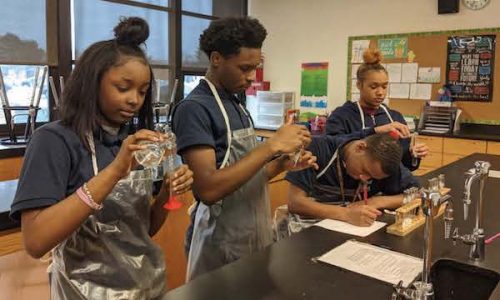
CPA’s Co-Principal Investigators collaborating to optimize the materials and volumes to test the impact of microgravity on tomato seed germination.
Proposal Summary:
The purpose of this investigation is to find out if microgravity affects the germination of tomato seeds. The study will consist of cherry tomato seeds and water to promote germination. The microgravity and ground control seeds will be inspected to see the ones that germinated and the ones that didn’t germinate. The main goal is to determine if a plant will germinate more or less when on the space station in a microgravity environment. This experiment will help astronauts if they want to try to grow their own fruits and vegetables while in space.
HONORABLE MENTION FINALISTS:
The Effect of Microgravity on Magnesium Sulfate Crystals
Grades 9-10, Chandler Park Academy High School
Co-Principal Investigators: Brian Buford, Kennedi Parker, Arianna Rashidi
Teacher Facilitator: Christopher Trepanowski
Proposal Summary:
The primary purpose of this research is to investigate the question of how does microgravity affect the growth of magnesium sulfate crystals. The group hoped to find differences between the crystals in microgravity and the ones here on Earth. They’re looking for different shape formations, length, width, and mass. Also, if the structure would change. During the process of preparing for the flight to ISS, the group decided to experiment before proceeding on with the investigation to be sure it was bound to work. While and before experimenting an advisor was present and in the room for safety reasons. The students in the group carried out the experiment twice by making a saturated solution of water and magnesium sulfate, once using purple food coloring. When the water reached its boiling point, the advisor added a different amount of water in each tube to carry out the experiment. Lastly, the students put each tube a different way to see which efficiently formed the crystals.
Tissue Regeneration in Microgravity
Grade 8, Chandler Park Academy Middle School
Principal Investigator: Jaiden Brooks
Co-Investigators: Erin Armstrong, Kayla Ayers, Arman Thompson
Teacher Facilitator: Dennis Washington
Proposal Summary:
Starfish are known for their ability to regenerate tissue and regrow limbs that have been damaged due to injury. Our proposal examines the effects of microgravity on the mechanisms responsible for the regeneration of tissue. The organism we will use to examine this effect is the Asterina starfish. Currently the effects of microgravity on tissue regeneration are unknown. We believe that tissue regeneration in microgravity is possible but, due to lower oxygen levels, this process might happen at a slower rate. We will test our hypothesis by carefully removing tissue from the aboral central disc of Asterina starfish. The starfish will then be placed and sealed in vials of a saltwater solution along with a kale nutrient solution. Upon the vial’s return to Earth we will examine the tissue from the aboral disc region to determine evidence of new tissue growth. We will compare the results of this experiment with a similar experiment conducted on Earth. With the data from our experiment, we hope to further our scientific knowledge of the regeneration of tissue in microgravity. The results of our experiment may even be useful to bioengineers and regenerative medicine in revealing how gravity affects tissue regeneration.
16. Galloway, New Jersey – Stockton University
Jump to Galloway’s Community Profile
SELECTED FOR FLIGHT:
The Effects of Nitrogen Fixation in Microgravity
Grade Undergraduate, Stockton University
Principal Investigator: Sophia Bradach
Teacher Facilitator: Peter Straub
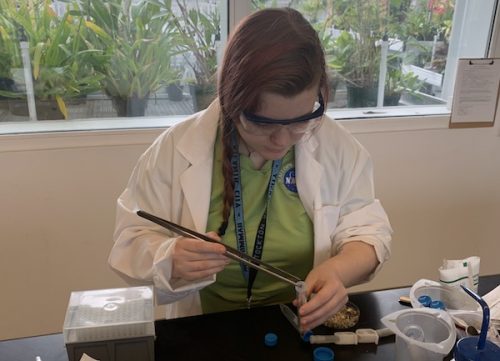
Sophia Bradach testing her flight experiment on nitrogen fixation in peas in the Stockton University plant growth facility.
Proposal Summary:
Humans have long dreamed of long-term space travel; it has been present in our media since the 1800’s. For this human dream to come into fruition the perfection of self-sustainable agriculture in altered gravity conditions must be attained. This experiment will investigate an essential part of sustainable agriculture under the pressures of microgravity, nitrogen fixation. In microgravity and on the ground, legumes are germinated in a confined environment allowing the fixation of nitrogen to occur then a fixative is introduced to freeze the experiment for analysis. Thereafter, nitrogen related compounds will be tested and quantified in both the plant tissue and synthetic soil used (vermiculite). The results of this experiment will be able to investigate the effects microgravity has on this important natural process under the strains of microgravity. This delicate symbiosis could effectively open the door to space colonization and long-term flights. The practical applications of this experiment open the door to foreign soil development and sustainable subsistence agriculture in space.
HONORABLE MENTION FINALISTS:
Bio-Resin: Microgravity Effects on Resin Water Resistance and Thermostability
Grade Undergraduate, Stockton University
Principal Investigator: Alex Blake
Teacher Facilitator: Dr. Pamela Cohn
Proposal Summary:
Across our daily lives we interact with resins almost constantly. Resins are a protective glue that can be used with various different materials, and could prove to be helpful in protecting natural components used in future space travel, exploration, and settlement. In order to sustain ourselves in space we need to be able to produce these resins while traveling, in addition to preserving the environment on earth. Proposed is a test of a thermoset resin from natural materials: Soy Protein Isolate and Condensed Tannins. This experiment will be tested in microgravity aboard the International Space Station (ISS) and on ground for comparison. This experiment can lead us to greater understanding of natural resin quality if produced amid space travel.
Will Tomatoes Grow Up in Space Using a Hydroponic System?
Grade Undergraduate, Stockton University
Principal Investigator: Emily Alter
Teacher Facilitator: Peter Straub
Proposal Summary:
My experiment that I have chosen to do is hydroponic planting. What hydroponic planting is planting without using soil instead nutrients are used for the plant to grow. This could be helpful to astronauts in space so they could get all their proper nutrients in space to remain healthy. This is important because a lot happens to your body under microgravity which changes the human body. If astronauts could grow their own food, they would have a healthier food alternative to vacuum packed foods. Also, could discover new growing techniques in the process which will give them many new options. My experiment will compose of using tomato seeds and I will be using Hydroponic nutrients solution. Since there will be 2 compartment one side will contain 15-20 tomato seeds and the other compartment will contain 4.6 mL of water/hydroponic solution. Once our experiment will get to space the clamp will be released. I am anticipating having the plant grow upward in the test tube. This will allow the seeds to sprout and have room to grow. If this experiment is successful is would be providing a new alternative source for astronauts to eat in space.
17. Springfield, New Jersey
Jump to Springfield’s Community Profile
SELECTED FOR FLIGHT:
Pond Microorganism Growth in Microgravity
Grade 7, Florence M. Gaudineer Middle School
Co-Principal Investigators: Jacob Cunningham, Samuel Levy, Simon Perez, Michael Urbach
Teacher Facilitator: Alison Gillen
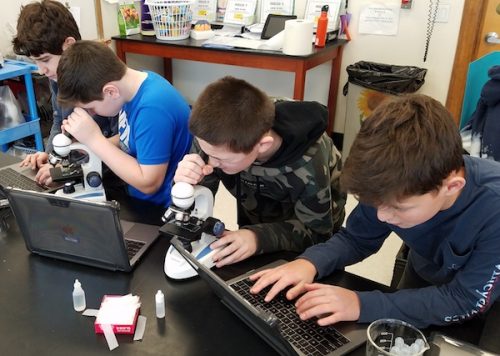
Simon Perez, Samuel Levy, Jacob Cunningham and Michael Urbach prepare to send pond microorganisms to the International Space Station.
Proposal Summary:
What is microgravity’s affect on biodiversity of pond microrganisms? Microorganisms were studied on Earth in a mock pond inside a test tube that was relatively the same diameter as the FME tube, using the right conditions for the organisms to thrive. Within several days, small bacteria started to develop. Then, protozoa began feeding on the bacteria. After about one-week, photosynthetic algae started to appear. As a result of this research, it is known that the organisms thrive on Earth, but it is unclear if they can thrive in microgravity conditions. Will the lack of waves and water currents cause the microorganisms to have excess energy to carry out their life activities, which may include reproducing? Will the progression of feeding levels be maintained in microgravity? Will the succession of microorganisms remain the same in microgravity as on Earth? After giving a rehydrated pond mixture 12 days to develop in microgravity a fixative will freeze all growth preserving the organisms for analysis upon return to Earth.
HONORABLE MENTION FINALISTS:
Growth of Aglaonema Plant
Grade 8, Florence M. Gaudineer Middle School
Co-Principal Investigators: Isabel Morais, Gianna Pintado
Investigator: Emily Yesowitz
Teacher Facilitator: Mr. Perone
Proposal Summary:
Our experiment is the study of Chinese Evergreen growth in space. We are conducting this experiment to see if the Chinese Evergreen will germinate with the impact of microgravity. We are conducting this experiment because if the plant does grow it will help to create healthier air for humans to breathe in space. We are planning to put 2 grams of organic potting soil and a small piece of Bounty paper towel soaked with 2ml of San Pellegrino water with four Chinese Evergreen seeds in volume 2 of our type FME 3. Then, we will put 1 ml of 10% neutral buffered formalin in volume 3 of the FME to act as our fixative. Last, we will put 2 milliliters of San Pellegrino water in volume 1. If we find that Chinese Evergreen does germinate in microgravity, we can conclude that they will impact the air similarly to the way they do on earth thus will create a safer environment for astronauts during flight. This will also lead to NASA sending more plants like the Chinese Evergreen into space. In conclusion, sending a plant like the Chinese Evergreen up to space will only improve the air quality of future space travel.
Will Apple Seeds Grow in Space?
Grade 5, James Caldwell Elementary School
Co-Principal Investigators: Oluwafemi Fatolu, Christopher Geitner, Kenneth Kamugisha, Oluwole Kuku
Teacher Facilitator: Cristin Zavocki
Proposal Summary:
This projects intention is to research and design an experiment that answers the question of this Biological System; will granny smith apple seeds grow in microgravity? We would like to conduct this experiment because we would like to know if apple seeds can grow as well in space as on earth? This will benefit us by giving astronauts something healthy to eat. We hypothesize that the seeds will successfully live in space with a successful beginning. The materials our group will need are granny smith apple seeds, soil, water, and 10% Neutral Buffered Formalin: appox. 3.7% formaldehyde in phosphate buffered saline. Once our FME is back on Earth we will be measuring the seed from microgravity to a seed that has been growing on Earth.
18. WNY STEM – Buffalo/Niagara, New York
Jump to WNY STEM’s Community Profile
SELECTED FOR FLIGHT:
The Effects of Microgravity on The Mating Habits of Hypsibius Dujardini
Grades 10-11, International Preparatory School at Grover
Co-Principal Investigators: Joseph Daniel Ruiz, Shyanne Cole Seiler, Saifullah Tayeb
Investigator: Imon Ahmed
Teacher Facilitator: Andrew Franz
Proposal Summary:
The investigation tests the impact of microgravity on the mating habits and reproduction of Hypsibius dujardini (tardigrades). Moreover, the investigating team is seeking to refine practices of culturing tardigrades in microgravity. If planetary travel is achieved, viable planetary scout organisms must be sent to the surface of these planets to begin terraforming and colonization. Being extremophiles, tardigrades may be able to be sent to the planet in tun state before a suitable biosphere has been established. If astronauts find that they have come out of tun state, maybe this is a signal that conditions are becoming right for all life. This is conjecture as technologies to quickly, efficiently, and cheaply travel to another planet are still in development, but it seems that parallel jumps in terraforming and space travel must be achieved if Mars really is a goal for humanity. Because of the adaptation ability and cryptobiosis of the tardigrade, it is a suitable “guinea pig” for being the first organisms to land on extraterrestrial soil. For analysis, sampling techniques are used to construct a growth curve of the Hypsibius dujardini culture.
HONORABLE MENTION FINALISTS:
Microgravity’s Effect on Geometric Pattern Formations in Escherichia Coli Biofilms vs. Normalized Gravity
Grades 11-12, Lockport High School
Co-Principal Investigators: Jeremy Stoddard, Kiera Richards
Co-Investigators: Allison Hanna, Jessica McClain
Collaborators: Haley Sanders, Ryan Brant
Teacher Facilitators: Mrs. S. Bochicchio, Mr. T. Schultz
Proposal Summary:
Biofilms cause significant damage to materials through the degradation of surface structures, yet most antimicrobials and chemicals cannot counter their growth. As a surface slime of DNA, proteins, and polysaccharides, biofilms create a massive defense against any invading organisms or killing compounds. Through the existence of persister cells and the extracellular matrix, biofilms remain impermeable to outside stressors. In a microgravity environment where antibiotics show rampant ineffectiveness, focus has shifted onto how to prevent the dissemination of biofilms onto critical laboratorial and life-support equipment and the transmission of festering bacteria to astronauts. In pursuit of ensuring the health of astronauts, we seek to analyze the potential modulation of molecular structures in lyophilized non-pathogenic Escherichia coli biofilms. Changes in the geometric formation patterns may indicate increased vulnerability to outside killing agents, potentially isolating the ISS from these disease transmitters. Previous experiments have been conducted to analyze changing geometric structures, chiefly with the testing of Pseudomonas Aeruginosa and Caulobacter crescentus, experiments highlighting the creation of three-dimensional column and canopy structures (Wooseong et al 2013), patterns different than the flat planes formed on Earth (EPFL, 2019). Through the usage of the Type 3 FME lab, conducted tangentially on Earth and the ISS, the growth of E. coli biofilms on a Teflon strip will be observed. Conditions will remain relatively constant between the ground and ISS experiments. Upon the FME’s return to Earth, results from the growth will be analyzed quantitatively through X-ray crystallography to observe any changes in protein structures and holdings.
The Effect of Anabolic Steroids on Muscle Atrophy in Microgravity
Grade 12, Wellsville Secondary School
Principal Investigator: Molly McKee
Co-Investigators: Emma Kinnicutt, Eric Morehouse
Collaborator: Isaiah Scott
Teacher Facilitator: Ross Munson
Proposal Summary:
Long term space travel is on the horizon, and with it comes problems that have yet to be solved. A major problem is muscle atrophy as it affects the amount of time an astronaut can spend in space (NASA). If no solution to prevent muscles from atrophying occurs, then long-term space travel is out of the question as the astronauts will be crippled upon returning to gravity (University of Texas). Due to this issue we asked ourselves, what is the effect of anabolic steroids on muscular atrophy in microgravity? Astronauts can experience muscle atrophy with up to 20% muscle loss in only five to eleven days of being on a mission (NASA). Using anabolic steroids could help prevent muscular atrophy in humans when administered correctly (Ullman). A positive result from our investigation could be helpful in the event of moving life to places other than Earth, as well as undertaking long term space travel. With this investigation, we hope to see an increase in muscle mass in our organisms in microgravity using small and measured amounts of anabolic steroids.
19. Shoreham, New York
Jump to Shoreham’s Community Profile
SELECTED FOR FLIGHT:
Can Mung Beans Germinate in Microgravity?
Grade 5, Wading River School
Principal Investigator: Louis Cerniglia
Collaborators: Jeffrey Ramirez, Christopher Votruba, Alex Zimmerman
Teacher Facilitator: Tara Constant
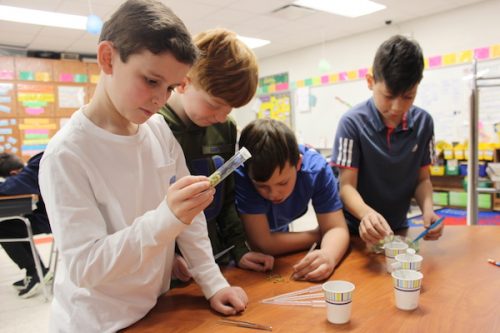
Young scientists examining their materials including mung beans to see how best they can be arranged for sprouting in space and on Earth.
Proposal Summary:
Will a Mung Bean plant take longer to germinate in microgravity than here on Earth? Mung Beans are very easy to grow and are a healthy food to eat. Mung beans have many benefits for health, including nutrients and high antioxidant levels, which may reduce chronic diseases, and aid in digestive health. Eating Mung beans may also help to maintain hydration, which is very important for astronaut health and wellbeing on the space station. Mung beans also germinate quickly, in just 4-6 days. The quick growth rate, together with the many health benefits, suggest that Mung beans would make a good food source for astronauts. The hypothesis is that Mung Beans will germinate faster on Earth than in microgravity.
HONORABLE MENTION FINALISTS:
The Effect of Microgravity on the Formation of 3-D Spheroids and Cell Apoptosis in Mammalian Cancer Cells
Grade 11, Wading River High School
Principal Investigator: Sofia Stirpe
Teacher Facilitator: Dana Schaefer
Proposal Summary:
Although new cancer research has saved many lives, cancers are still difficult to diagnose and treat effectively. Cell morphological changes in microgravity can advance the development of anticancer drugs. Many cellular morphological changes in microgravity, such as the formation of 3-D spheroids, are caused by cytoskeletal alterations, and also by changes in gene expression. These 3-D spheroids resemble malignant tumors, and studies indicate that their production in microgravity correlates with an increase in cell apoptosis (death). Since the future lies in planet colonization, it is necessary that humans gain a better understanding of cancer cell responses to microgravity. This experiment seeks to understand how microgravity affects the formation of 3-D spheroids in mammalian cancer cells.
How does Microgravity Affect the Rate of Germination of a Scarlet Nantes Carrot Seed, with the Provided Nutrients (Water, Minerals)?
Grade 8, Albert G. Prodell Middle School
Principal Investigator: Alex Zhang
Co-Investigators: Shannon Redlein, Charles Vescovo, Nick Worthington
Teacher Facilitator: Kevin Nohejl
Proposal Summary:
In our experiment, we are testing the Scarlet Nantes carrot seed’s ability to germinate under microgravity given water and nutrients. We decided on the carrot due to it’s amazing health benefits such as reducing risk of certain cancers, like colon cancer where 893 people in Japan have tested this in carrots. (medicalnewstoday) They also include a lot of nutrients that are essential for the human body, like vitamin C and A. We will have the scientist water the plant by opening and closing the clamp separating the water and seed on the day of the arrival. Afterwards, we will have the scientists wait 3 weeks, as it takes 1-3 weeks for a carrot to germinate. During the time of three weeks the carrots will germinate between the arrival and until docking. Once the three weeks have passed, the scientist will then open the other clamp adding the fixative to the seed. This will stop the germination process, but not kill the plant so we can analyze the results back on Earth. This information that we use to compare on Earth would be able to prove if will be able to grow plants, specifically root vegetables, in space, which can be significant for reasons discussed later.
20. Bethany, Oklahoma
Jump to Bethany’s Community Profile
SELECTED FOR FLIGHT:
The Effects of Microgravity on Culicidae Eggs
Grades 10-11, Bethany High School
Co-Principal Investigators: Ben Brody, Jenna Cobb, Dalyn Gomez, Jackson Heffron, Hudson Howard, Lazarus Larson, Rachel Privette, Andrew Ratterman, Alejandro Reyes, Reese Rhodes, Margarita Rojas-Lopez, Zane Wright
Teacher Facilitator: Amie Sellers
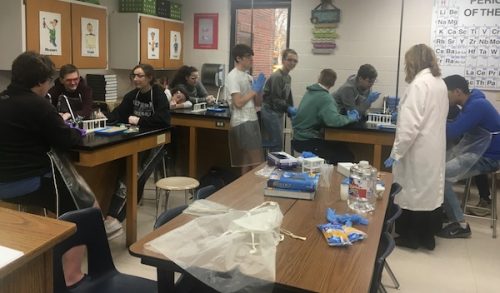
Bethany Student Researchers prepare the experiment, “The Effects of Microgravity on Culicidae Eggs” for flight.
Proposal Summary:
The experiment is aimed at giving data, insight, and knowledge on the effects of microgravity on observable and physical abnormalities in mosquitos. The team will be looking exclusively at observable differences and similarities. The team may be able to observe developmental markers, glean how mosquitoes grow in length, and deduce differences between mosquitoes born on Earth and ones exposed to microgravity.
HONORABLE MENTION FINALISTS:
Bacteria’s Growth and Adaptation to Varying Concentrations of Antibiotic in Microgravity
Grade 9, Bethany High School
Co-Principal Investigators: Khyron Duke, Zane Gillespie, Josiah Hoekman, Alex Marsh, Donavon Pietzsch, Stewart Summers
Teacher Facilitator: Amie Sellers
Proposal Summary:
The experiment proposed would measure the growth and adaptation of bacteria in the presence of varying concentrations of antibiotics. This experiment will be useful in years to come because of the possibility of more and more humans living in zero gravity. Studies have shown that taking antibiotics for small illnesses will decrease the effectiveness of the antibiotic because of the bacteria’s ability to adapt. This effectively renders the antibiotic useless. If humans are eventually able to live in areas without gravity, it would be beneficial to know the effects of antibiotics in that situation. Although this experiment has been done in the gravity of Earth this experiment can give us a contrast from Earth’s gravity compared to zero gravity medical situations.
Effects of Microgravity on Toughness of Fiber-Reinforced Lightweight Concrete
Grades 5 and 7, Bethany Earl Harris Elementary School and Bethany Middle School
Co-Principal Investigators: Bryant Huynh, Grant Huynh, Crew Hunter, Maddox George
Teacher Facilitator: Andrea Stewart
Proposal Summary:
Concrete is a universal construction tool both above the ground and below. Most concrete structures use rebar. However, some construction, such as detailed structures, thin structures, and artistic structures cannot use rebar. A good solution is using fiber-reinforced concrete. Also, lightweight concrete has many uses in construction and is easier to pump long distances. One way to increase the strength of lightweight concrete is by adding microfiber. Microfiber may be used in structures to decrease plastic shrinkage cracking and improve durability. The problem is that the microfiber isn’t always positioned correctly within the cement. When there is force on the concrete, the fibers are not in the correct place to strengthen the concrete and it may break. This experiment will give insight on how micro-gravity affects the orientation and distribution of microfibers in the concrete. The samples cured in microgravity and on Earth will be tested for toughness. In theory the microgravity sample will be tougher because the microfibers will be better mixed and aligned.
21. Enid, Oklahoma
Jump to Enid’s Community Profile
SELECTED FOR FLIGHT:
Pinto Bean Germination Experiment
Grade 6, Longfellow Middle School
Co-Principal Investigators: Georado Pacheco Arriaga, Trace Beddoes, Cheyanne Stufflebeam
Co-Investigators: Michelle Hernandez, Pablo Mora, Kalie Moreno, Tuan Taevin Nguyen, Melany Ramirez
Collaborators: Daniel Benor, Logan Bruner, Dareon Cole, Tyler Daniell, Miguel Ochoa Diaz De La Vega, Anijah Grim, Myah Helms, Emilio Isaias, Saint Langinmej, Phoenix Lawson, Eduardo Mendoza, Sheila Mosqueda, Chance Nafus, Jude Newman, Alex Nieto Vargas, Bweua Peter, Marlene Ramirez, Ally Richey, Kourtney Wright
Teacher Facilitator: Jessica Patnode
Proposal Summary:
What effect does microgravity have on the germination of pinto bean seeds? Pinto bean seeds have all the required energy to germinate, when water is introduced. An experiment conducted on the ground and in microgravity will provide information about any differences in directional growth of sprouts, as well as the rate of germination. The results of the investigation can be used to determine if seeds can be grown in space and potentially used as a food source.
HONORABLE MENTION FINALISTS:
The Efficiency of CBD in a Microgravity Environment
Grade 11, Enid High School
Co-Principal Investigators: Zade Coleman, Aaron Dillard, Bryslan Mercer, Aubree Tatro
Teacher Facilitator: Teresa Ponce
Proposal Summary:
Hemp is a strain of the cannabis sativa plant species and is grown for its industrial or medical uses. The CBD oil is extracted from the hemp seed and it is strongly recommended by health professionals. Nausea is a prevalent issue that astronauts face on a consistent basis while they’re in space. CBD can help with stomach issues, such as reduce vomiting. “It has been shown to help heal ulcers and acid reflux,” said Dr. Kenneth Brown, MD, a board-certified gastroenterologist, who often recommends CBD to his patients (Brown,2018). The seeds have such a rich nutritional profile, what is there not to like about it? We are seeking to provide all of these benefits to the astronauts and how we can help them address their nausea while in space. With their help, we are hoping to be able to germinate this seed in space. We also believe that this will help us gain a greater understanding of how this will benefit people even more, and how it will respond in space as well as also understanding how it can benefit on Earth.
Do Brine Shrimp Grow Faster in Microgravity than on Earth?
Grade 11, Enid High School
Co-Principal Investigators: Zoe Adam, Olivia Waldroup
Co-Investigators: Jennifer Jacklick, Evencilla Malolo, Silvia Miranda
Teacher Facilitator: Dusty Hugaboom
Proposal Summary:
The experiment will analyze the promotion of growth in brine shrimp in microgravity and compare the rate of growth to that here on Earth. The hypothesis is stated as this: if the salinity levels of water is matched with an equal amount of sugar, then the glucose increase should produce more available energy and promote the growth of the shrimp. With the recorded data, the goal of settlement and habitation in space in permanence is more feasible.
22. Pittsburgh, Pennsylvania – University of Pittsburgh
Jump to Pittsburgh’s Community Profile
SELECTED FOR FLIGHT:
Effects of Microgravity on the Oxidation of 3-D Printed Aluminum with Unique Topography
Grade 15, University of Pittsburgh, Swanson School of Engineering
Co-Principal Investigators: Marissa DeFallo, Nikolas Vostal
Teacher Facilitator: Dr. Sachin Velankar
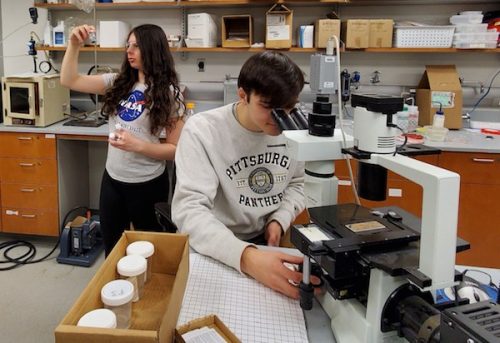
Marissa is visually inspecting the aluminum for signs of corrosion while Nik is checking under a microscope for small pits.
Proposal Summary:
Aluminum alloys are used throughout the aerospace field, including aboard the International Space Station, due to its light weight and high strength properties. Aluminum corrodes when it is oxidized and forms a white powder-like substance on the surface of the material. In the presence of chlorides, such as salt, corrosion can tunnel through the aluminum and form pits which have a lower modulus and leave parts weakened. These corroded areas can lead to structural failures if they are not studied and prevented. One solution to prevent failure is by engineering surface textures to intentionally corrode sacrificial sections of a part. With recent advances in metallic 3-D printing it is easier than ever to create intricate aluminum parts with extreme precision. The importance of conducting this experiment in microgravity is because the force of gravity on earth trumps the surface tension of water at size scales exceeding a few millimeters. This will allow parts with large surface gradients to hold the salt water solution away from the main body, showing the effectiveness of different surfaces. This experiment will give insight into how aluminum corrodes in microgravity and provide useful data for creating corrosion-resistant aerospace parts in the future.
The Effect of Silver Nanoparticles on the Immune Response of Daphnia Magna in Microgravity
Undergraduate and Graduate, University of Pittsburgh, School of Pharmacy and Swanson School of Engineering
Co-Principal Investigators: Samantha Bailey, Jordan Butko, Amanda Carbone, Prerna Dodeja
Teacher Facilitator: Sravan Kumar Patel
Proposal Summary:
Since the beginning of the space program in the 1960’s, the effect of space on earthly phenomena has intrigued scientists. Particularly, the effect of microgravity on the immune system is of prime importance in terms of astronaut health. The highly controlled environment aboard the International Space Station would necessitate the use of antibacterial products, many of which often contain silver nanoparticles. Exposure of these nanoparticles has been associated with significant toxicity in the liver as well as brain. Prior experiments investigating the model organism Daphnia magna in space indicates its ability to adapt to living in microgravity. Moreover, the organism can produce a quantifiable immune response. Building upon these principles, this proposal aims to investigate the specific effects of silver nanoparticles on the immune response of Daphnia magna.
HONORABLE MENTION FINALISTS:
The Effects of Microgravity on the Transcriptome of the Live-Attenuated Influenza Vaccine
Grades 16-17, University of Pittsburgh, School of Pharmacy and Swanson School of Engineering
Co-Principal Investigators: Roisin M. Sabol, Isabelle To, Natalie Weckesser
Teacher Facilitator: Samuel Poloyac, PharmD, PhD
Proposal Summary:
The influenza virus represents a huge healthcare burden; the seasonal influenza affects 48 million Americans and precipitates almost 1 million hospitalizations annually. The last pandemic flu outbreak, occurring in 2009, affected 60 million Americans. According to the Center for Disease Control and Prevention (CDC), influenza vaccination reduces the risk of illness by up to 60% during seasons when most circulating viruses are well-matched to the vaccine. Due to the continual antigenic drift of seasonal influenza viruses, the virus continually mutates, requiring annual reformulation of the vaccine. While efforts are made to anticipate virulent influenza strains for the upcoming year, vaccine efficacy is not guaranteed. Microgravity has known effects on enhancing expression of bacterial virulence genes and can thus plausibly trigger viral mutations that affect virulence as well. With these principles in mind, the purpose of this proposal is to identify virulence genes influenced by microgravity in the live-attenuated influenza vaccine (LAIV). This investigation will examine transcriptomic changes in the influenza virus while in microgravity with the hypothesis that microgravity conditions induce increased virulence gene expression. Identifying these genes will foster the development of live-attenuated vaccine formulations that offer stronger immunogenicity and efficacy, and create opportunities to carry out vaccine interventions to decrease virulence gene mutation.
Effect of Microgravity on Blood Coagulation Using Lyophilized Plasma
Grade 16, University of Pittsburgh, School of Pharmacy and Swanson School of Engineering
Co-Principal Investigators: Gabriel Detter, Sydney Dyne, Lindsay Heck, Hyunwoo Kim, Jacob Shrubb
Teacher Facilitator: Dr. James Coons, Pharm D, FCCP, BCCP
Proposal Summary:
With the ever-increasing frequency of space exploration, it is important to understand how the normal blood coagulation process is altered when exposed to a microgravity environment. Blood clots can be triggered by a multitude of factors and can lead to pulmonary embolisms, strokes, or other life-threatening conditions. Anticoagulation is critical when it comes to getting minor cuts, undergoing surgery, or receiving a direct current cardioversion during an arrhythmic episode. Preparing for these types of situations becomes increasingly important as the duration and frequency of space expeditions increases. By understanding the impact of microgravity on the coagulation process, we can be better prepared for injuries that occur during space flight that could alter the course of the mission or require surgery. This can lead to adjustments of anticoagulation agents such as Warfarin or Apixaban based on how the blood coagulation process is altered when exposed to these conditions. There have been studies mimicking the effects of microgravity on the coagulation process, but very little data exists on how space travel will alter the formation and structure of a blood clot. Through this experiment, a blood clot will be induced within microgravity using lyophilized plasma and will be studied on Earth in order to analyze its structure and the concentration of necessary coagulation factors. The data gained from this experiment can be used to optimize anticoagulation regimens for patients, as well as prepare for serious injuries that require surgery while aboard the ISS.
23. Sumter, South Carolina
Jump to Sumter’s Community Profile
SELECTED FOR FLIGHT:
The Effects of Microgravity on Artemia Franciscana’s Growth Rate
Grade 6, Alice Drive Middle School
Co-Principal Investigators: Anna Alan, Addie Griffin
Co-Investigators: Katelyn Makowske, Mary Carter Smith
Teacher Facilitator: Dr. Marina Mosneaguta
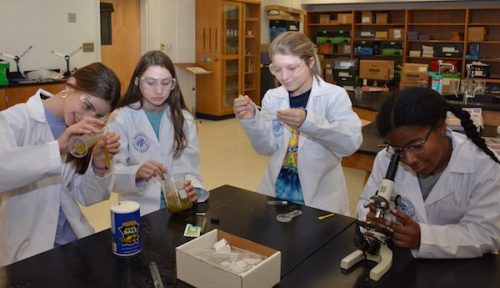
Mary Carter Smith, Katelyn Makowske, Addie Griffin and Anna Alan are engaged in researching Artemia franciscana’s growth rate.
Proposal Summary:
This experiment proposes that microgravity will affect Artemia franciscana’s growth rate. This investigation will explore the growth rate and the differences of Artemia franciscana when it is grown in microgravity in comparison with a sample grown in regular gravity. Artemia cysts are grown in microgravity and the growth and characteristics are compared with those of a ground experiment to see if microgravity had any effect on the Artemia. This experiment can be used to form further studies about the effects of microgravity on human muscles or the growth of organisms in microgravity and how it affects living organisms.
HONORABLE MENTION FINALISTS:
The Effect of Microgravity on the Germination of Brassica Juncea Seeds Using Sodium Hydrogen-Carbonate
Grade 7, Alice Drive Middle School
Co-Principal Investigators: Michael Lauzon, Joshua Miller
Co-Investigators: Claire Baker, Hannah DuRant
Teacher Facilitator: Dr. Marina Mosneaguta
Proposal Summary:
This investigation hypothesizes that a Brassica juncea seed exposed to sodium hydrogen carbonate in microgravity will increase plant germination rates. An investigation from Alice Drive Middle School during SSEP mission 12 came up with the idea to see if plants will grow at all in sodium polyacrylate; their experiment was successful. This experiment still uses the growth medium, sodium polyacrylate, however plant growth is being taken to the next level in this experiment by the use of sodium hydrogen carbonate to see if it will help the plant grow faster. This is beneficial because when astronauts have a shortage of food, it will be a quick food supply because it has been noticed by this team’s prior research that the carbon in the sodium hydrogen carbonate makes growth and germination rates faster. For the investigation, sodium hydrogen carbonate was chosen as our carbon substance because it can activate the carbon effect that is needed without going flat over a short period of time. The carbon might go flat because when there are any open or unsealed areas the carbon gas escapes. If the carbon factor was to go flat it might have a bad effect on Brassica juncea seeds. For the soil substitute, sodium polyacrylate is the material that was chosen because it can be used as an organic soil substitute. Sodium polyacrylate is an organic soil substitute because it is lightweight and easy to package. Therefore it is believed that sodium hydrogen carbonate will help plants grow in microgravity.
The Effects of Microgravity on Lolium Multiflorum Seeds Germination Using Miracle Gro
Grade 6, Alice Drive Middle School
Co-Principal Investigators: Sami Almosadder, Elizabeth Singkhonket
Co-Investigators: Cody Inman, Promise Mitchell
Teacher Facilitator: Dr. Marina Mosneaguta
Proposal Summary:
This SSEP experiment explores how Miracle-Grow reacts to sodium polyacrylate mixed with Lolium Multiflorum ryegrass seeds in microgravity. The hypothesis is that the Miracle Gro solution will increase the growth of the seeds in microgravity. Miracle Gro is a 36-0-6 fertilizer containing 36 percent nitrogen and 6 percent potassium. Plants rely on nitrogen to germinate properly. Nitrogen is a major part of chlorophyll which is found in the chloroplast of a plant cell. Chlorophyll is used by the plant during photosynthesis. Seedlings in microgravity treated with Miracle Gro will germinate and then grow larger than seeds treated with Miracle Gro on Earth. Once returned to Earth, the two experiments will be compared for the amount of germinated seeds and the length of the seedlings. The comparison will include observing for a blade or blades of grass and the length of the plant root. Studies have shown that it is difficult to grow plants in microgravity, and if the experiment is successful, the amount of fresh produce grown in space will increase. Fresh produce is essential for astronauts, as they need the variety of nutrients in their diets. A healthy diet can also positively impact their moods. Ryegrass seeds were chosen for a few reasons: The seeds are small and thin enough to fit in the minilabs, and when colonizing other planets, a food source for livestock will be useful.
24. Knox County, Tennessee
Jump to Knox County’s Community Profile
SELECTED FOR FLIGHT:
Effects of Microgravity on the Efficiency of Lactic Acid Fermentation in the Production of Kimchi
Grades 11-12, Farragut High School
Co-Principal Investigators: Rachel Constantin, Blake Cragen, Taylor Sussmane
Teacher Facilitator: Neely R. Tonos
Proposal Summary:
Fermented foods have impacted Asian food culture since ancient times. Fermentation serves as a preservation method for perishable foods and a source of probiotics that are vital to a healthy digestive system. As plans for long-term interstellar travel and extraterrestrial settlements become more prevalent and achievable, it is imperative that the scientific community conduct research on microgravity’s effect on essential biological processes that contribute to the health of participants of these plans, like lactic acid fermentation, the process used to make kimchi (fermented cabbage). Lactic acid is produced when bacteria (notably L. mesenteroides) resorts to anaerobic respiration as the principle method of survival; this usually means submerging the cabbage in water to deprive the cells of oxygen. To determine microgravity’s effects on the fermentation process, a sample of cabbage will be sent to the International Space Station where it will be submerged in water and left to ferment. Upon its return to Earth, a simple titration (acid-base neutralization method) will be conducted to provide an estimate of the amount of lactic acid that was produced. After being compared with data obtained from a “ground-truth” experiment, the nature of fermentation in different gravity environments can be reasonably concluded.
HONORABLE MENTION FINALISTS:
Soybeans and the Production of Nitrogen in Microgravity
Grade 5, Beaumont Magnet Academy
Principal Investigator: Asha Goodall
Co-Investigators: Dolan Cruze, Julius Schoenbach-Lee, Otis Bivens, Olive Simmons
Teacher Facilitator: Jessica Reiner
Proposal Summary:
Do soybeans create the same amount of nitrogen in space as they do on Earth? Crop rotation benefits nitrogen-depleted soil through a chemical process called nitrogen fixation. A simulated environment found in microgravity may stunt the production of nitrogen in the soil compared to the soil found here on Earth. Retrieving a soil sample from a local farm that is preparing to start a three year cycle of crop rotation will help determine if nitrogen fixation can take place in microgravity for hopes of future use in space. If this can be done, farms can have a better chance of producing better crops in future settlements in space. The soy beans themselves can be used for many beneficial items on the International Space Station and in space travel in the future. Perhaps soybeans could be used to create recyclable air? The first step is determining if they can grow in a microgravity environment and comparing those results to a control sprout on Earth. The possibilities of potential uses for soybeans in space is limitless if tests prove successful.
The Effect of Microgravity on Mold Growth
Grade 7, Carter Middle School
Co-Principal Investigators: Camille Gabetta, Adeline Rankin, Kaitlyn Rutherford
Teacher Facilitator: Katrina Whipple
Proposal Summary:
Mold, a common problem with food and homes, has been a tyranny for centuries. Of course, mold on walls is a problem that everyone faces, though it can be removed without much trouble (in most cases). Mold in contact with food, however, is not easily removable. When mold is on bread, it basically and almost immediately tarnishes it. A common mold that affects bread and other such foods goes by the name of Rhizopus stolonifer, or black bread mold. Black bread mold is a fast-growing and quick-spreading type of mold (Bullerman). Mold such as this one forms on bread when its spores come in contact with the surface. Mold is especially a problem when it is accidentally consumed. If ingested, this mold can sometimes cause infections (bioweb “Black Bread Mold, Rhizopus stolonifer”-Topic). It is not ideal to have an infection in space, considering how not all necessary treatment may be provided (especially later on). There is also the fact that mold could decrease supply of bread if not careful, therefore leading to limited types of food in a space environment. Since bread is a large part of many people’s diet, a decrease could lead to dire situations or worsen them. No one would want to run out of food, especially if an emergency occurs. As referenced from a personal experiment, bread will become brittle if the mold lingers for too long. With just a simple mixture of water, bread, and mold spores, mold can grow.
25. Bandera, Texas
Jump to Bandera’s Community Profile
SELECTED FOR FLIGHT:
Will the Growth of Brewer’s Yeast be Affected in a Microgravity Environment?
Grade 6, Bandera Middle School
Co-Principal Investigators: Lillian D’Spain, Kylie Minton, Hailee Segura, Cassandra Steffler, Hannah Wells
Teacher Facilitator: Bette Koenig
Proposal Summary:
This investigation will aid recent advances in astronaut nutrition by exploring whether the growth of brewer’s yeast is affected in a microgravity environment. This investigation will determine if two samples allowed to grow for a three-week period in different amounts of gravity vary developmentally.
This research is important for many reasons. The proper application of brewer’s yeast through fermentation to foods grown in space may potentially allow astronauts to greatly extend the shelf life of these foods. This will make space missions less dependent on foods sourced from Earth. In addition, many foods fermented with brewer’s yeast are known to have positive benefits to hair, skin, eyes, mouth, and your digestive tract. As NASA itself has said, “When crews venture further into space, traveling for months or years without resupply shipments, the vitamins in prepackaged form break down over time, which presents a problem for astronaut health”. Fermentation may be a completely viable and innovative way to make foods last longer without causing damage to the vitamins that we derive from fruits and vegetables.
HONORABLE MENTION FINALISTS:
The Effects of Microgravity on Radish Seed Germination
Grade 6, Bandera Middle School
Co-Principal Investigators: Dominic Kinsey, Cody Johnson
Co-Investigators: Caitlyn Roberson, Matthew Trombly
Collaborator: Joshua Sartin
Teacher Facilitator: Bette Koenig
Proposal Summary:
The purpose of the experiment is to see if radish seeds will germinate differently in a microgravity environment. This will be done by conducting an experiment with two FME-2 tubes. Both tubes will contain radish seeds put into cotton in one section and water in the second section. One tube will be sent to the International Space Station and the other will be grown here on Earth. Once both tubes are back on Earth, the direction and length of the roots and the size of the leaves will be compared. Then, both groups of seeds will be planted to see if there is a difference in the way that they continue to grow. Radishes have many health benefits such as, fiber, vitamins, and antioxidants. This will help boost astronauts’ immune systems and digestive systems.
Zinnia Seed Germination in Microgravity
Grade 6, Bandera Middle School
Co-Principal Investigators: Kourtney Frerich, Cinthia Gutierrez, Sarah Le
Teacher Facilitator: Hannah Powell
Proposal Summary:
This SSEP experiment will determine if Zinnia seeds will be able to germinate in microgravity. Our group chose this topic because we wanted to find out if plants would be able to grow in space. Zinnias are commonly grown in microgravity. NASA has tested growing Zinnias before, according to NASA, First Grown Flower in Space Station’s Veggie Facility. If the plants could be able to grow healthily in space, it would affect the future. The materials needed for this experiment will be including Zinnia seeds, tap water, Alliance Biologics PGPB (plant growth promoting bacteria), sodium chloride (salt), and Potting soil mix from Tractor Supply Co. Plant growth promoting bacteria is a bacterium that will encourage the seed to grow healthier. This bacterium is used often used in agriculture. This experiment will also need the FME minilab 3 tube. On day A=0, the astronaut will unclamp Clamp A, and then shake the two volumes together. Once the days for the seedling to germinate are over, the astronaut will remove the last clamp, which is provided with salt, and shake the mixture once more. Sodium chloride will prevent the seed from germinating further more. The salt will absorb the water, which will cause the seed to stop growing. This experiment will be in space for four weeks. We will also be conducting another experiment on Earth, using the same materials. After we get the results of the experiment from space, we will compare it from the other experiment conducted on Earth.
26. Burleson, Texas
Jump to Burleson’s Community Profile
SELECTED FOR FLIGHT:
The Effects of Microgravity on Lentil Growth
Grade 7, STEAM Middle School
Co-Principal Investigators: Macie Davis, Olivia Earley, Alex Mercer, Ava Monroe, Itzel Perez-Orozco
Teacher Facilitators: Alyssa Sanchez, Mrs. Lentz
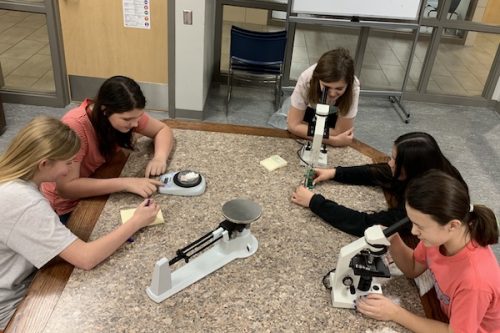
STEAM Middle School’s Team Lentil (Alex Mercer, Ava Monroe, Olivia Earley, Itzel Perez-Orozco, and Macie Davis) analyzes growth of their lentils while fine-tuning their experiment for Flight Safety Review.
Proposal Summary:
What is the effect of microgravity on the growth of lentils? Lentils were chosen to determine if they are a solution to help bone density issues and bone degeneration while onboard the ISS. When astronauts enter space bones degenerate, which means they slowly go away and lose muscle tone. Lentils can help bones and muscles develop and strengthen because they contain calcium, magnesium, potassium, and protein. This investigation hopes to determine – Will lentils germinate the same in microgravity as they do in gravity? Are microgravity conditions an adequate environment for farming and developing crops? Are lentils an appropriate crop to cultivate while onboard the ISS?
HONORABLE MENTION FINALISTS:
The Effect of Microgravity On Nylon 6 10
Grade 7, Nick Kerr Middle School
Co-Principal Investigators: Keira Clotfelter, Jack Dietz, Tommy Gifford, Waylan Kisor
Teacher Facilitator: Allison Buckingham
Proposal Summary:
How will microgravity affect the creation of Nylon 6-10? The hypothesis for the experiment is microgravity will change the molecular structure of Nylon 6-10. Changing the molecular structure would change the applications of the nylon on earth. When the chemical comes back from a microgravity environment, it could become more adapted to the Earth’s gravity, increasing its flexibility, strength and density. Normal Nylon 6-10 is already incredibly strong, so microgravity could possibly make it even more useful. The ratio of carbon atoms make Nylon 6-10 unique therefore can be used for many things. The Nylon 6-10 has a high chemical resistance which means that it can have different applications including tethers, ropes, underwear, toothbrushes, filler substances and repairs. It could also have applications in space and even on the ISS. Since Nylon 6-10 is a natural insulator to electricity, it is often used for phone lines and chargers, which is useful for electrical needs. Nylon 6-10 has a high durability and melting point which makes it one of the most bought nylons on the market. The Nylon 6-10 makes more applications than any other nylon in the world, because of it’s ingredients. We will use Polypropylene, and Sebacoyl Chloride in the experiment.
Curing Coronary Artery Disease
Grade 6, Nick Kerr Middle School
Co-Principal Investigators: Olivia Davis, Aiden McNeelege, Brady Miller, Cash Miller
Teacher Facilitator: Allison Buckingham
Proposal Summary:
In our experiment, we will be testing to see if Aspirin will get rid of plaque. Coronary Artery Disease, CAD, is when fatty deposits or plaque builds up inside the lining of a coronary artery and once it gets too large it will rupture and create a blood clot. Once it clots then it can cause heart attacks and strokes. This disease is affecting millions of Americans and costing the United States billions of dollars a year. About 630,000 Americans die from heart disease each year and over half of those deaths are from coronary artery disease which kills about 366,000 people a year. If our experiment works, we could save millions of Americans from heart attacks and strokes. This would also benefit any astronauts that might have coronary artery disease so they wouldn’t have to come back down to earth to seek treatment. Allowing them to remain on the ISS and keep doing experiments. The time that they stay on the ISS could be life-changing because all it takes to ruin one experiment is one person missing.
27. Lufkin, Texas
Jump to Lufkin’s Community Profile
SELECTED FOR FLIGHT:
Can Radish Seeds Develop in Microgravity?
Grade 7, Lufkin Middle School
Co-Principal Investigators: Shariah Jackson, Patrick McGrew
Teacher Facilitator: Amy Rush
Proposal Summary:
Can radish seeds (Raphanus raphanistrum) develop in microgravity? If radish seeds can germinate in microgravity, then roots will emerge from the seed. Radishes are used for vitamins A, C, E, B6, and other minerals. They can also provide an immunity boost for the entire body, and are beneficial to the heart. Radishes are a healthy food source and can help astronauts keep up their nutrients. To address how well radish seeds will germinate in microgravity or whether they will germinate at all in this environment, radish seeds are placed in cotton. Water is applied to the seeds while on the ISS. The radish seeds will hopefully germinate in microgravity, and the length will exceed expectations. Polypropylene glycol is will be applied, stopping germination, before return to Earth.
HONORABLE MENTION FINALISTS:
Does Milk have a Decreased Bacteria Growth in Microgravity?
Grade 7, Lufkin Middle School
Co-Principal Investigators: Austin Brown, Nolan Howard
Teacher Facilitator: Amy Rush
Proposal Summary:
We purpose to answer the question: Does milk have a decreased bacteria growth in microgravity? Milk is currently used on Earth as an ingredient for dairy products and a source of drinking. We want to test the spoilage of milk in space to see if it is possible for microgravity to slow down the rate at which bacteria grows. We wanted to research this topic because it could be a possible resource later on in space discovery, and learning about the spread of this bacteria inside of the milk could allow it to be stored for longer periods of time and will not expire as quickly. To carry out this experiment, we are going to get 2.4mL of powdered milk and 3mL of distilled water along with another 3mL of 50% polypropylene glycol. We will then let the milk begin the spoiling process. Finally, we will combine the 50% polypropylene glycol and milk to help slow down or stop the process of the milk spoiling.
Culinary Lavender Germination
Grade 7, Lufkin Middle School
Co-Principal Investigators: Brianna Adame, Perla Garcia, Marlee Jones
Teacher Facilitator: Amy Rush
Proposal Summary:
We hope to find out the exact period of time lavender (Lavandula angustifolia) will take to germinate while in microgravity. We wanted to research this because lavender is an important plant on Earth and can grow in many types of climates from the cold north to the warm south. It is a great plant to have around because it is used in teas, essential oils, seasoning in food, or as an air freshener. It is also used in medicines that help with anxiety, restlessness, insomnia, depression, and headaches. Lavender is so useful it is used in 5 out of the 7 continents. We think lavender would be useful if humans ever colonize space and knowing how long it takes for it to grow would be very helpful. We will send 10 seeds and water in a Type 3 Mini-Lab. We will also grow culinary lavender on Earth and give it the same amount of light and water. We will compare the results of the experiment on Earth to the results of the experiment in microgravity.
28. Lumberton, Texas
Jump to Lumberton’s Community Profile
SELECTED FOR FLIGHT:
Mixing of PVA Fibers with Concrete in Microgravity
Grade 11, Lumberton High School
Principal Investigator: Austin Howard
Investigator: Lucas Mason
Teacher Facilitator: Susan Letourneau
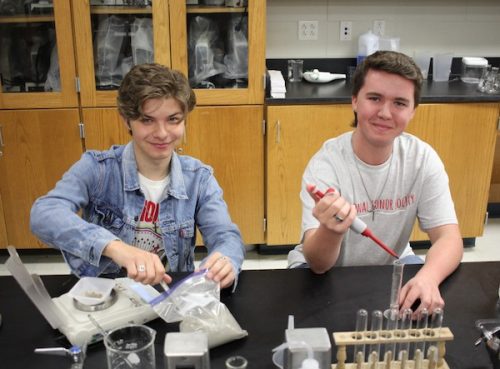
Lumberton physics students Lucas Mason and Austin Havard prepare for their microgravity experiment with PVA fibers in concrete.
Proposal Summary:
The experiment consists of Quikrete fast-setting concrete, RMS702 PVA fibers and water. PVA fibers are extremely light, have a high tensile strength and are used to reinforce concrete. The viability of concrete as a structural material in microgravity depends upon both the ability to transport as many materials as possible through the conservation of space by using lighter materials and also upon the ability of said materials to resist breakage. PVA fibers, as opposed to other materials to reinforce the concrete, are being used because they contain the appropriate ratio between weight and tensile strength, are commonly used to reinforce concrete and bond with the concrete at the molecular level. The investigation is expected to determine to what extent PVA-reinforced concrete is able to be used in microgravity.
HONORABLE MENTION FINALISTS:
The Effects of Microgravity on the Infection Rate of Coliphage λ on E. coli
Grades 11-12, Lumberton High School
Co-Principal Investigators: Richie DiGiovanni, Tanner Skatrud, Anthony Tran
Co-Investigators: Zander Carrillo, Ethan Hansen, Lanie Arevalo
Teacher Facilitator: Stephanie Wright
Proposal Summary:
This experiment will examine the effects of microgravity on the growth and infection rate of coliphage λ on E. coli. This could make a large impact on the use of viral therapy for humans in the future. For the investigation, sample of E. coli will be brought to the space station and the coliphage λ will be mixed with the E. coli and let rest for a set amount of time after which the mixture will then be killed and brought back down to the surface to be observed for the amount of E. coli bacteria left and compared to the experiment done on Earth.
Brine Shrimp Spaceflight Experiment (Artemia Salina Maturation)
Grade 10, Lumberton High School
Co-Principal Investigators: Brian Cassaday, Brent Haley, Campbell Fuller, Megan DiGiovanni
Teacher Facilitator: Caitlin Zuber
Proposal Summary:
This team will discover the potential for aquatic life in space through the Marine Life Spaceflight Experiment presented. Through the hatching, maturation, and extermination of Artemia Salina in the microgravity environment provided by the International Space Station, NASA will have a better understanding of the lifestyle and agricultural limits of deep space travel.
29. Pharr, Texas
Jump to Pharr’s Community Profile
SELECTED FOR FLIGHT:
The Effects of Microgravity on the Growth and Development of Artemia salina
Grade 10, Thomas Jefferson T-STEM Early College High School
Co-Principal Investigators: Anette Diaz, Anthony Pliska, Teresa Garza
Teacher Facilitator: Gabrielle R. Peralez
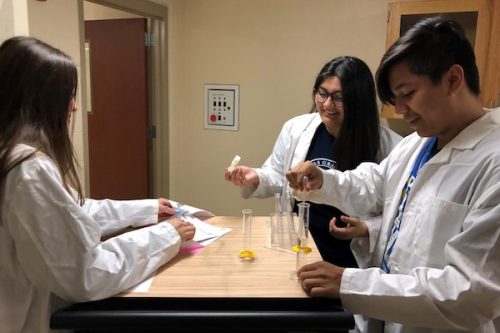
Thomas Jefferson T-STEM Early College High School students Anette Diaz, Anthony Pliska, and Teresa Garza finalizing their experiment for the Student Spaceflight Experiment Program.
Proposal Summary:
In theory, gravity can affect an organism’s growth. The experiment will compare the growth of a type of brine shrimp, Artemia salina, in both microgravity and gravity conditions.
HONORABLE MENTION FINALISTS:
The Effects of Microgravity on Eisenia Fetida
Grade 11, Thomas Jefferson T-STEM Early College High School
Co-Principal Investigators: Bianca Mora, Marco Ortiz, Emmanuel Ramirez, Jonathan Rivera
Teacher Facilitator: Israel Serna
Proposal Summary:
NASA currently has a space garden known as “Veggie” onboard the International Space Station that grows a variety of different plants. This is beneficial to the astronauts up in space because the plants grown in “Veggie” are a nutritious source of food that help alleviate the stress that their bodies go through while in space. We believe that the introduction of Eisenia fetida onto the ISS “Veggie” garden will provide astronauts with a more efficient method of fertilizing their crops. On Earth, Eisenia fetida are commonly used to enrich the soil and help crops grow. We hypothesize that this method can also be applied to the “Veggie” space garden with similar, effective results. The purpose of our experiment is to observe and analyze how Eisenia fetida behave in microgravity. The experiment will be performed in a 10mL tube with one clamp attached. Volume 1 will contain 4mL of soil as the dependent variable, 2mL of decayed apple matter as a food source, and two young Eisenia fetida as the independent variable. Volume 2 will contain 1mL of Carbaryl substance to kill the Eisenia fetida before it lands back on Earth. Its results will allow us to have a better understanding of the effects of microgravity on Eisenia fetida and could prove useful to astronauts and their well-being.
Can Low Gravity Affect the Structure of E. coli?
Grade 12, Thomas Jefferson T-STEM Early College High School
Principal Investigator: Linovy Torres
Teacher Facilitator: Brandon Naumann
Proposal Summary:
For the recommended experiment, we will use a type 2 FME sample of E. coli. Since E. coli is anaerobic and does not require oxygen, it is a good candidate bacterium that will survive in a silicone tube without complications. What will be tested to see if microgravity can affect the structure of the organism itself over a certain amount of time. Particularly the membrane or cell wall will change shape or loosen during its time in microgravity because the lesser gravity pushing down on the bacteria may cause it to stretch out or become wider in order to adapt to its new environment. Once ready to be observed, the bacteria will be compared to the same species of bacteria that were treated the same, but under normal earth conditions.
30. Bellevue, Washington
Jump to Bellevue’s Community Profile
SELECTED FOR FLIGHT:
Effects of Microgravity on Penicillium Chrysogenum’s Ability to Inhibit Cell Wall Synthesis in Staphylococcus Epidermidis
Grade 8, Open Window School
Co-Principal Investigators: Armaan Thomas, Atiwit Miles Chanbai, Cadence Ching
Teacher Facilitator: Elliot Skopin
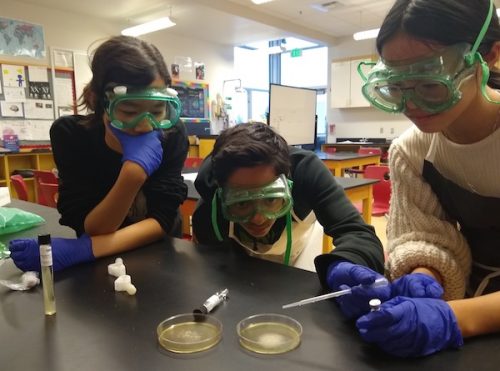
Open Window School’s eighth grade team continues to refine their SSEP experiment as they prepare it for launch to the International Space Station in the Spring/Summer.
Proposal Summary:
What are the effects of microgravity on Penicillium chrysogenum’s ability to inhibit cell wall synthesis in Staphylococcus epidermidis? The question asks how the microgravity environment on the ISS will change P. chrysogenum’s ability to prevent cell wall synthesis in S. epidermidis. Studies have shown that bacteria virulence will decrease in microgravity, so studying P. chrysogenum’s growth in space will accompany that knowledge to create a better understanding of antibiotic effectivity in microgravity. Insight regarding how P. chrysogenum develops in space as well as how its ability to interfere with bacterial cell wall bonding is impacted by microgravity could help future space explorers create simpler and more sustainable ways to develop antibiotics in space when needed. Additionally, the proposed experiment can provide more information and general knowledge for other types of antibiotic molds.
HONORABLE MENTION FINALISTS:
Generational Development of C. elegans in Microgravity
Grade 6, Open Window School
Co-Principal Investigators: Adarsh Sanjay, Annicka Huse, Jachin Lee, Jian Zhou Chen
Teacher Facilitator: Andrew Mechling
Proposal Summary:
This experiment is designed to investigate the effects of microgravity on the reproduction ability of the Caenorhabditis elegans nematode. Because the genomic structure of C. elegans is analogous to that of humans, it is an ideal model organism for this investigation. The results of this experiment will be vital in the future, as currently there is very limited knowledge regarding the effects of microgravity on the health and development of humans living entirely in microgravity, and if they will have special medical needs related to unique developmental changes caused by prolonged microgravity. The experiment will allow multiple generations of C. elegans to grow aboard the ISS, which will be analyzed for developmental changes (e.g. body length) upon return. It is hoped that this highly significant experiment will be selected for flight and provide mankind with valuable information.
An Exploration in Growing Dolomite Crystals in Microgravity
Grade 5, Open Window School
Co-Principal Investigators: Anja Bajari, Sofia Del Villar, Michelle Imasaki, Samantha Stiles, Sophie Velda
Teacher Facilitator: Andrew Mechling
Proposal Summary:
The question we are investigating is: Do dolomite crystals grow more effectively or in different patterns in microgravity compared to those grown on earth? Dolomite has many known medical benefits such as assisting the body with cellular reproduction, helping to strengthen muscles, bones, skin, nails, teeth and blood cells. On average it takes about two weeks to grow Dolomite crystals. In the microgravity environment onboard the International Space Station (ISS), researchers can grow protein crystals that are larger and more well-ordered than crystals grown on Earth. However, it is not clear that natural crystals from earth materials will grow in a similar pattern. Dolomite is a sedimentary rock that grows Aragonite crystals when white vinegar is applied. Growing Dolomite crystals has never been tested in a microgravity environment. If we can get enough evidence that Dolomite crystals grow faster in microgravity, then we can start producing more crystals in space to benefit more people every day.
31. Hayward, Wisconsin
Jump to Hayward’s Community Profile
SELECTED FOR FLIGHT:
Fish Egg Development in Microgravity
Grade 7, Lac Courte Oreilles Ojibwe Middle School
Co-Principal Investigators: Evan Heath, Kane LaRonge, Thomas White
Teacher Facilitator: Tammy Moncel
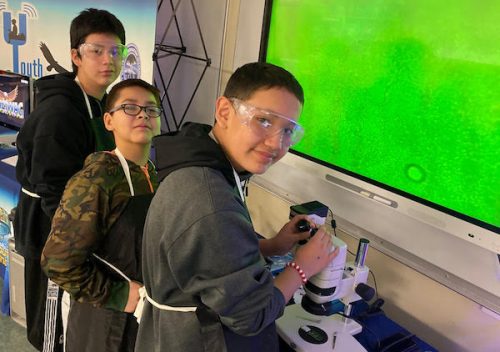
Lac Courte Oreilles Ojibwe School seventh graders Evan Heath, Thomas White and Kane LaRonge use high powered microscopes to investigate trout egg development.
Proposal Summary:
The investigation compares the hatching and development of fish in microgravity to their hatching and development in gravity. If fish can develop in space, it would expand the food supply available for space travel. Astronauts could eat fish, helping them to maintain health and prevent muscle loss. Fish have many valuable nutrients including protein. Fish could be a food source, or could be used in aquaponics. In addition to determining if fish eggs will hatch and develop in microgravity, the ground investigation will be used to assist the trout egg vendor in researching longer-term packaging techniques for shipment.
HONORABLE MENTION FINALISTS:
Wild Rice (Manoomin) Germination in Microgravity
Grade 10, Lac Courte Oreilles Ojibwe School
Co-Principal Investigators: Kylie Dishaw, Raini Kingfisher
Co-Investigator: Emma Revak
Collaborators: Neah Billyboy, Davion Neweiashe
Teacher Facilitator: Wendy Fuller
Proposal Summary:
The proposed investigation will lead to a greater understanding of how wild rice will germinate in microgravity. It is expected that germination will occur with wild rice being in microgravity. Wild rice would be important to put up in space for Native American culture and it’s important to have another grain in space for food.
Fermentation of Milk into Cheese in Microgravity
Grades 9 and 12, Lac Courte Oreilles Ojibwe School
Co-Principal Investigators: Aubrey Conger, Savanah Larson
Co-Investigator: Hailey Banuchie
Collaborator: Cali Perry
Teacher Facilitator: Wendy Fuller
Proposal Summary:
Food is a needed resource for any human in space for both nourishment and comfort. Understanding if the fermentation process is similar in microgravity as it is on Earth will lead to a greater variety of foods that can be offered to astronauts. This experiment will show if the fermentation process of changing a perishable food substance such as milk into a nutrient rich fermented food choice such as cheese is possible in microgravity.
32. iForward-Grantsburg, Wisconsin
Jump to iForward-Grantsburg’s Community Profile
SELECTED FOR FLIGHT:
Do Killifish Eggs Develop and Hatch in Microgravity?
Grades 6-8, iForward Public Online Charter School
Principal Investigator: Kirsten Nichols
Co-Investigators: Rachelle Nichols, Josiah Kreuser Peterson, Brandon Orth, Isaac Stanaway
Teacher Facilitator: Andrea Konrath
Proposal Summary:
The investigation studies the development and hatch rate and development of killifish eggs – specifically Fundulopanchax sjoestedti – in microgravity, providing information on a potential source of protein for future space study. The experimenters hypothesize that the development and hatch rate of the killifish eggs will be different in microgravity than here on Earth, with 80% or 8 out of 10 eggs hatching and beginning development in microgravity and the control lab eggs showing greater success. The rate of hatching of these eggs is interesting because they are extremely hardy and have the potential to survive long flights in space, thus serving as a possible protein source.
HONORABLE MENTION FINALISTS:
How Does Microgravity Affect the Oxidation of Copper?
Grade 9, iForward Public Online Charter School
Co-Principal Investigators: Evelyn Allworden, Daxton Duberstein, Faith LeMone, Andrew Nichols
Teacher Facilitator: Mark Dilley
Proposal Summary:
For our proposal, we are testing if microgravity affects the oxidation of copper. We want to see if the growth rate speeds up or slows down, as well if more rust grows or less. For our experiment, we will be using a type 3 fluid mixing enclosure. In one will be the copper, in another distilled white vinegar. One quarter of cotton damped in 2ml 5% white vinegar process on the copper. In the last section will be a drying agent, silica desiccant. Copper doesn’t take very much time to rust at all, so we will just see how much it can rust if it can. This is important because copper is a very multi-use material that we use a lot on Earth, so seeing how long it will last without oxidizing after getting wet in microgravity will be useful information.
Does Microgravity Affect the Efficacy of the Antibiotics Ampicillin and Gentamicin?
Grade 9, iForward Public Online Charter School
Co-Principal Investigators: Anita Finch, Henry Gandy, Hannah VanDeLeygraaf
Teacher Facilitator: Laura Kavajecz
Proposal Summary:
Our experiment seeks to determine if the Antibiotics Ampicillin and Gentamicin will get stronger and more effective in a microgravity environment. If selected, we will be sending a type 2 FME in space with several paper discs impregnated with two different antibiotics. When our experiment returns, we will be testing the impregnated filter discs on laboratory samples of both Escherichia coli and Bacillus subtilis. We will test the potency by conducting a Kirby Bauer assay, to compare the zones of inhibition. We believe the antibiotics will get stronger in space because of the shear stress of microgravity. Since there is less friction, the antibiotics will be free to move around, rather than rest in the FME. We hypothesize that the antibiotics will become more potent. We know antibiotics are used to treat many bacterial infections. Many infections are getting too strong for the antibiotic making infections harder to cure on Earth. We also know that antibiotics are less effective for bacterial infections in space which could be dangerous for the astronauts in the future (Fajardo-Cavazos, et. al.; Benoit).
